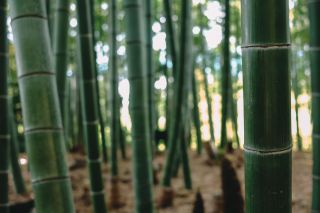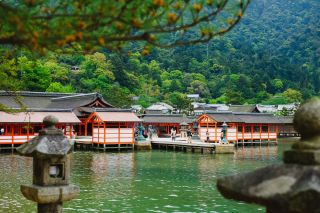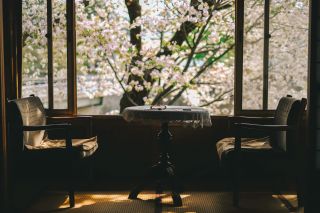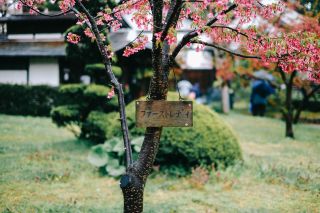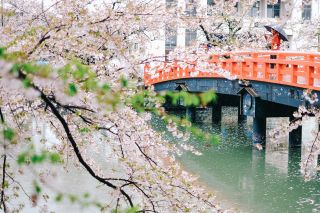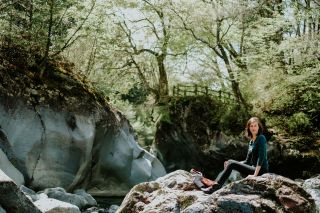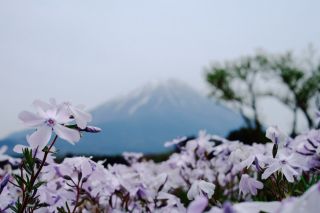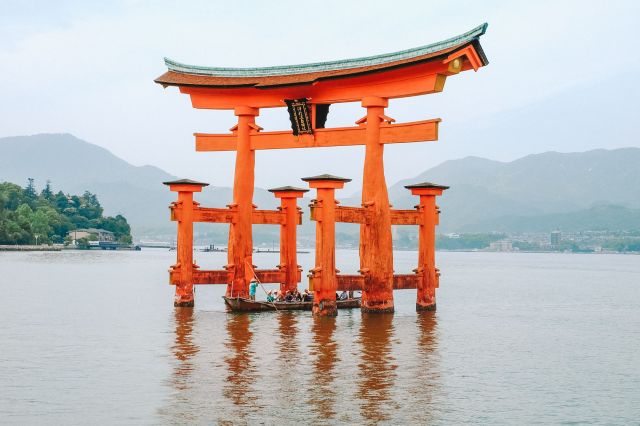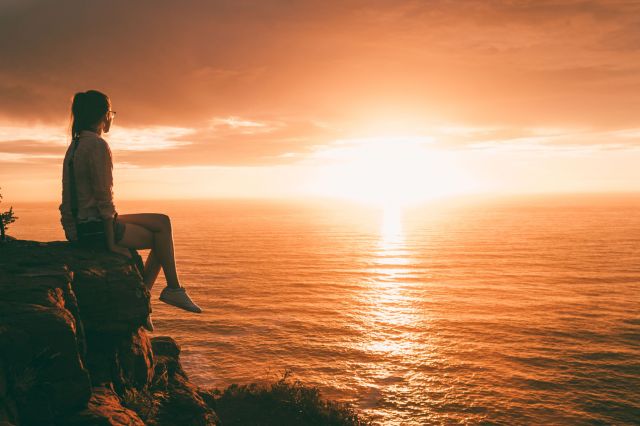Before you start to read this itinerary, there’s a very important question you have to ask yourself: Are you a “do it all, see it all” traveler? Or do you prefer to take things slow and steady? If the first describes you: perfect, you’re going to LOVE this itinerary for two weeks in Japan. If you you fall into the second camp, allow me to explain why you might still enjoy this whirlwind tour of Japan without getting overwhelmed…
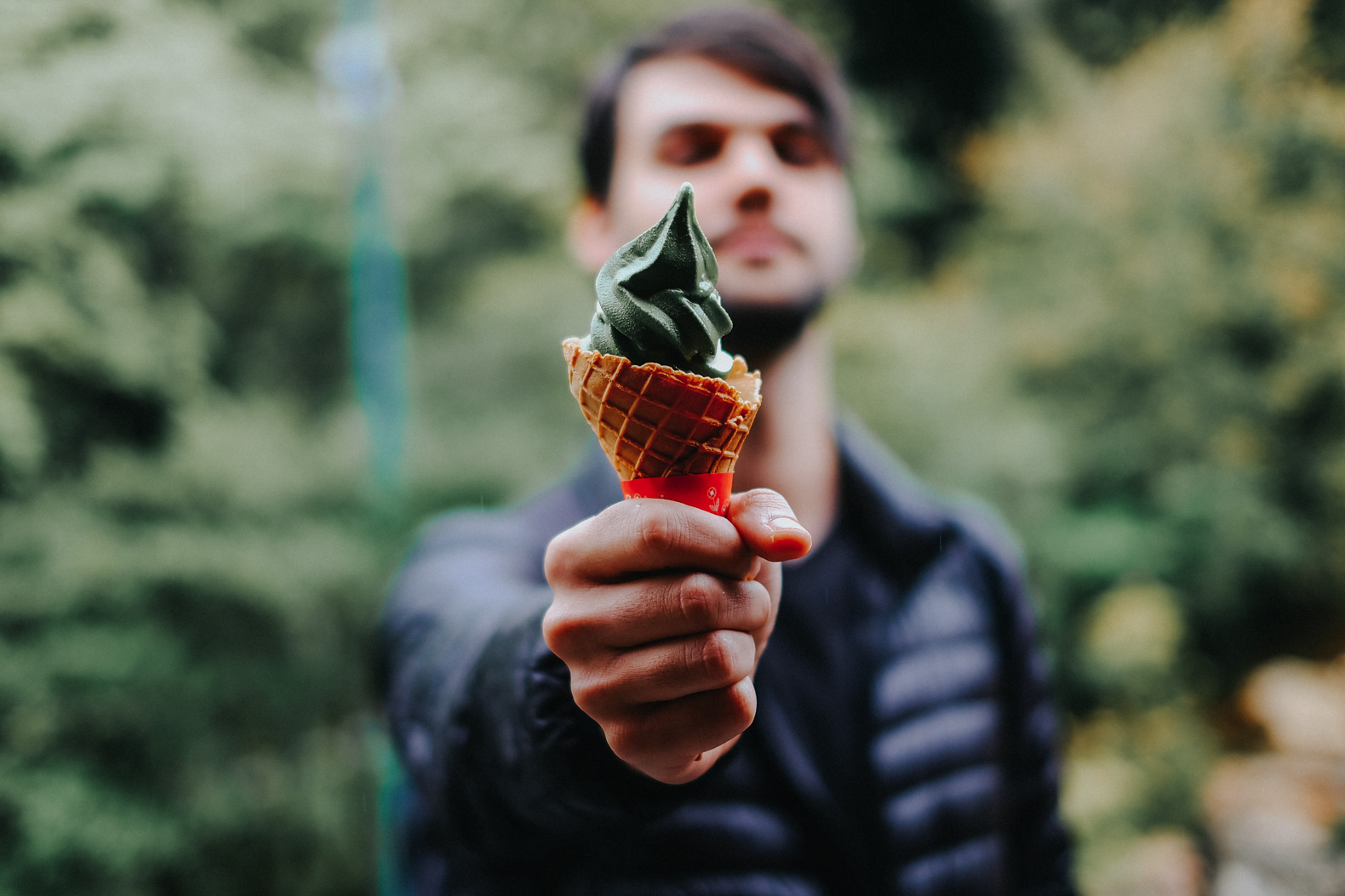
Why visiting 12 locations in 14 days is completely doable in Japan
The key to see Japan in an affordable and efficient way is the Japan Rail Pass . This pass allows you to take unlimited super fast “bullet trains” between locations, which is critical in a country that is surprisingly big (150% the size of the UK!). Here’s why the bullet train makes it work:
- You can make it between huge stretches of Japan in relatively little time.
- The train is so comfortable, that traveling to your next destination feels relaxing.
- Every train station has coin lockers, where you can store your backpack while you explore a city and haven’t checked into your Airbnb or hotel yet. This means you can pop into a new place, store your stuff, and get going.
Let’s look at the awesome experiences packed into these two weeks, and then you can tell me if you think it’s crazy or kinda clever 😉
Recommended accommodation in Japan
I stayed a lot of places in Japan, but out of those can only recommend a few. Here are the two specific spots I stayed in that I absolutely loved during my time in Japan.
- Sumiyoshi Ryokan (Takayama) – Absolutely the best place we stayed in Japan. Such friendly hosts, amazing traditional Japanese ryokan, and it’s entrancing to see your in-room breakfast get cooked before your eyes. It does get completely sold out at times so booking in advance is advised!
- Nikko Backpackers Nikkoriso (Nikko) – Technically a hostel, we booked a private couples room, which was beautifully decorated. But what made this place special is that the hosts happened to recognize us at the train station and gave us a ride! That was so lucky and so kind.
- Airbnb or Booking.com (any large city: Tokyo, Osaka, Kyoto) – We mostly stayed in Airbnb in large cities. That said, It can be hard to find the location because of the complex Japanese address system, the fact that the addresses are often in Japanese and the hosts sometimes don’t speak much English, so be prepared to improvise 😉
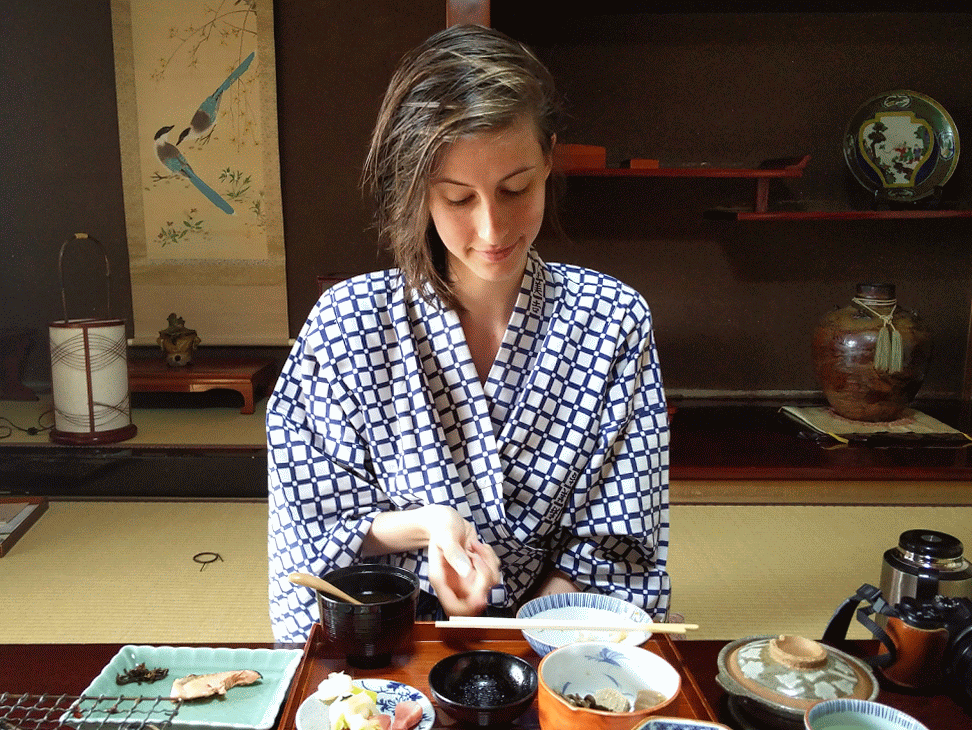
Eating our in-room breakfast at a ryokan in Takayama, Sumiyoshi Ryokan , in the Japan Alps!
At least once during your trip in Japan, I do recommend staying in a ryokan, which is a traditional Japanese inn. You can read my entire post about staying in a Ryokan in Japan to learn what to expect and how to find a ryokan that fits your budget!
How to prepare for a trip to Japan
Here are a few ways I really recommend being prepared before you actually travel to Japan. In a lot of places you can “wing it”, but I think Japan really favors the prepared! Some things are a lot easier (or mandatory) to do before you land in the country.
- Buy a Japan Rail Pass, as they can only be purchased OUTSIDE the country. They’ll mail you a voucher which you can redeem in the airport. I later calculated that the JR Pass saved me more than $450 in train tickets. You can use this super helpful website to compare different Japan Rail Passes to see which one makes the most sense for your trip – both financially and in terms of the areas you want to visit.
- Plan your train travel with Hyperdia – Hyperdia is an amazing English-language timetable tool for Japanese trains. You can also use it to calculate whether the Japan Rail Pass will save you money based on your Japan itinerary by looking at the standard train costs.
- Get an offline-friendly Japan guidebook – It can be very useful in Japan to have a guide available offline. I personally don’t like to rely on my phone to get around! I tried 3 different travel guide books for planning my trip, and this travel guide book was the best one (and was just updated).
2 weeks in Japan
Here is what you’re going to see in this incredible two week Japan itinerary! One important thing to note is that this itinerary is optimized for seeing cherry blossoms in Hirosaki, in northern Japan. If you are not visiting during the later part of the cherry blossom season, you can swap out Hirosaki for another destination. I would’ve loved to spend more time in Osaka or Nikko, so those are great options for extending your trip!
Where to go for two weeks in Japan (especially during cherry blossom season!)
- Day 1: Arrive in Tokyo
- Day 2: Take the train to Kyoto
- Day 3: Enjoy the highlights of Kyoto
- Day 4: Day trips to Fushimi Inari Shrine & Nara Deer Park
- Day 5: Remember the history of Hiroshima
- Day 6: Miyajima, Himeji, Osaka
- Day 7: Take the train to Takayam in the Japan Alps
- Day 8: Day trip to Shirakawa-go
- Day 9: Travel to Aomori in Northern Japan
- Day 10: Spend the day at the Hirosaki Cherry Blossom Festival
- Day 11: Experience beautiful Nikko
- Day 12-13: Tokyo
- Day 14: Mt. Fuji
Day 1: Arrive in Tokyo
Today is about getting adjusted. About realizing: OMG I am in Japan right now, and my universe is in chaooooos! There’s no pressure to do anything in particular besides finding your hotel or Airbnb, try to order food in Japanese for the first time, and experience a
<a href="http://www.bbc.com/news/world-asia-38660860” onclick="ga(‘send’, ‘event’, ‘Affiliate Link’, ‘Click’, event.target.getAttribute(‘href’));”
target=”_blank">complicated Japanese toilet .
No pressure, right?
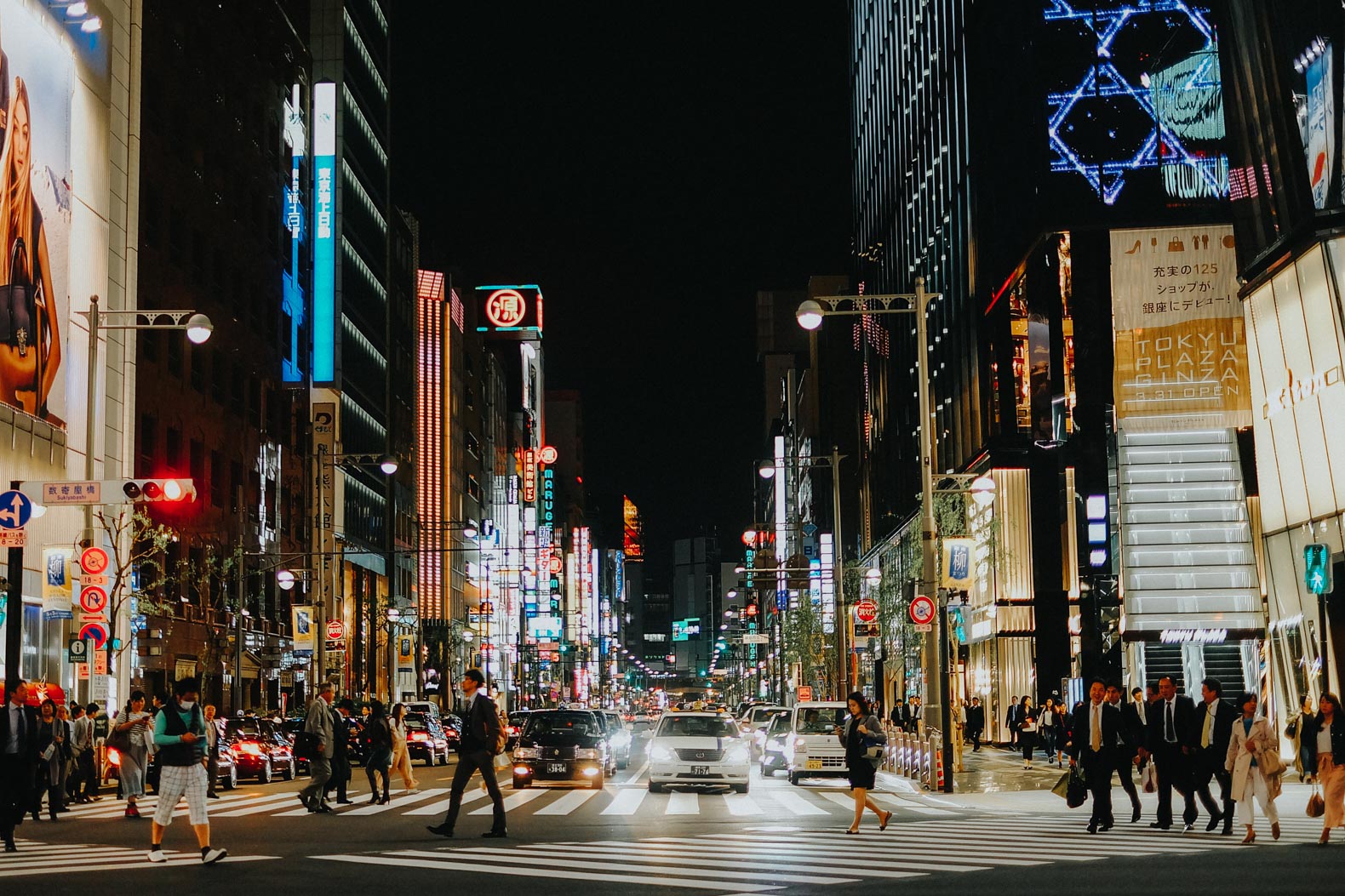
Tokyo’s Ginza , an upscale shopping district. Streets are lined with shops carrying Chanel and Prada. This area in the heart of Tokyo is very close to the Tsukiji fish market , where my top Tokyo restaurant recommendation is located!
That said, depending on when you arrive you might have some time to really spend exploring Tokyo. We’re going to come back to Tokyo at the end of the trip, so our first day is really just about getting faimiliar with the city. Here are a couple of ideas of things to do in Tokyo
Things to do in Tokyo for first-time visitors to Japan
- Go to Tokyo’s famous Robot Restaurant.
It’s just one of those things that is “so Japan” you have to see it to believe it.
During this 90-minute show robots in costumes sing and dance while you eat dinner
and down Japanese beer.
Book Robot restaurant tickets in advance
because as weird as it sounds, this is a super popular thing to do.
- Enter an immersive digital art museum.
This limited, interactive art show is one of the most popular things to do in
Tokyo. There may literally not be a better place in the city for instagram photos than this.
Book tickets to the teamLab Borderless Digital Art Museum
(children 3 years old and younger can enter free!).
- See Tokyo by night from its tallest building, Tokyo Skytree. Last admission
is at 9:00PM, and you can even
buy skip the line tickets
before you go. We didn’t have skip-the-line tickets and ended up waiting
almost an hour to get to the top. If you want to make it even more memorable, you can
have dinner overlooking Tokyo
at the Skytree’s Panorama restaurant 😱
- Just explore your neighborhood. It’s pretty much guaranteed that no matter
where you stay, there’s going to be an awesome point of interest right
in your vicinity. Go outside, pop into a totally overwhelming electronics store,
accidentally go into the “adult” section of the comics shop, pass by noisy pachinko parlors. There is nothing like people-watching in Japan. - Get your first sushi meal! I had the best sushi of my life at Sushi Zanmai (すしざんまい 本店) which is located in the super famous Tsukiji fish market . You can also try out conveyer-belt sushi, which is an experience of its own. Indulge in some sake while you’re at it!
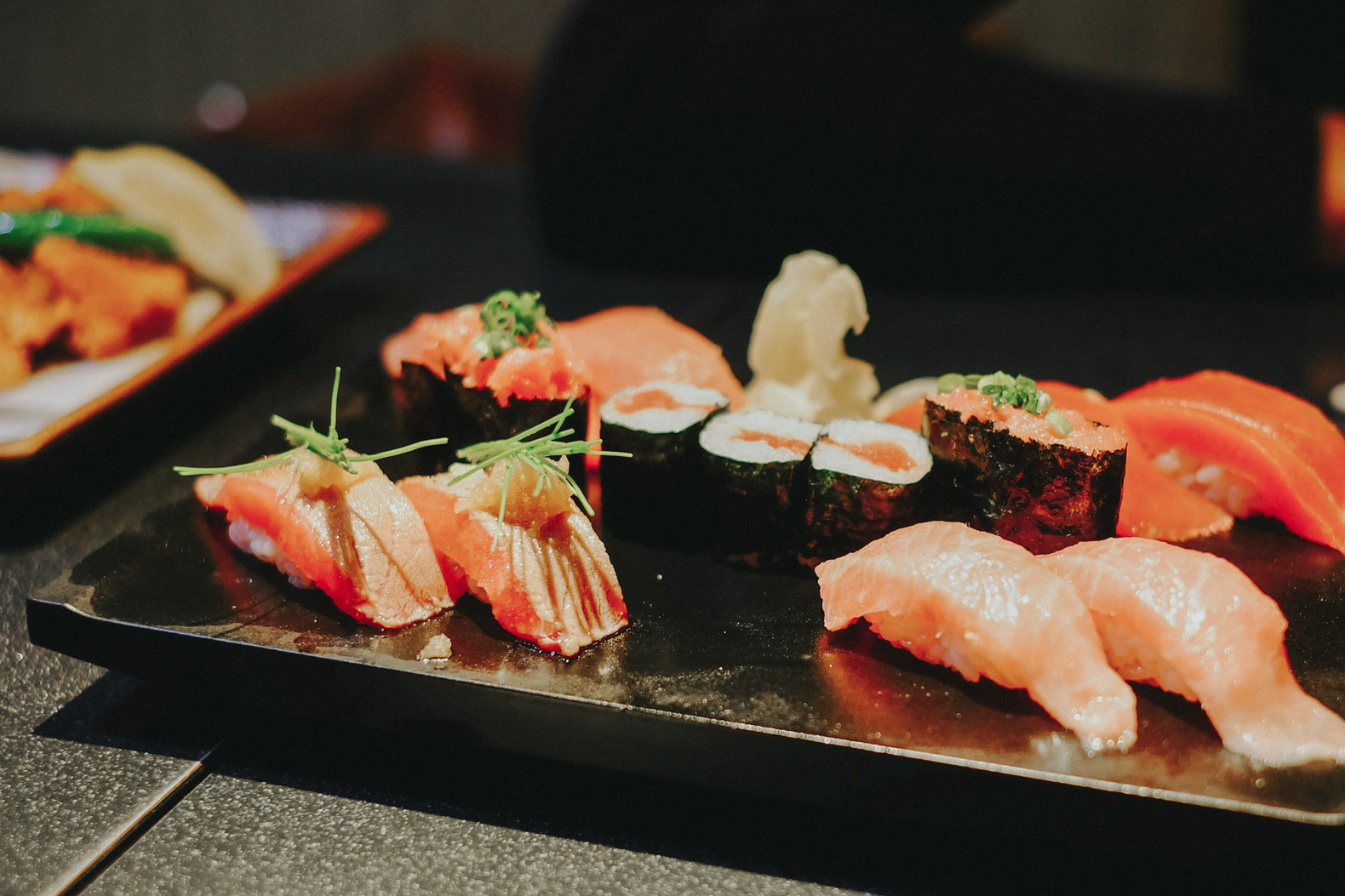
After your first night in a probably miniscule Japanese hotel, the next morning is time to hit the road for Kyoto, where we’ll spend three nights!
Day 2: Take the train to Kyoto
Kyoto is considered the cultural capital of Japan. Why not? It was Japan’s official capital for nearly 700 years. Here you’re going to get a real taste for what traditional Japan was like, by visiting shrines and temples erected hundreds of years ago (or more!). Besides architecture, Kyoto also has an incredible food scene. Here is where you can try Japan’s famous multi-course meal, called kaiseki .
But we’ll get to all that later!
For now, store your stuff in a coin locker at the Kyoto train station and catch the bus or train to the Saga-Arashiyama Station. Getting from there to our first stop, Tenryu-Ji is as easy as following the flow of people. After that, we’ll visit the neighboring Arashiyama bamboo forest . The final stop of the day is the super shiny Golden Pavillion .
For more details, you can read my in-depth Kyoto itinerary, but the main points are all mentioned here in this post!
Tenyru-Ji
Get ready to start taking off your shoes! Every shrine or temple you visit will require that you remove your shoes to enter. Luckily these places have soft wooden or tatami floors, so removing your shoes feels like a relief after long days of walking. And don’t worry – no one will steal your shoes. This is Japan ✌️
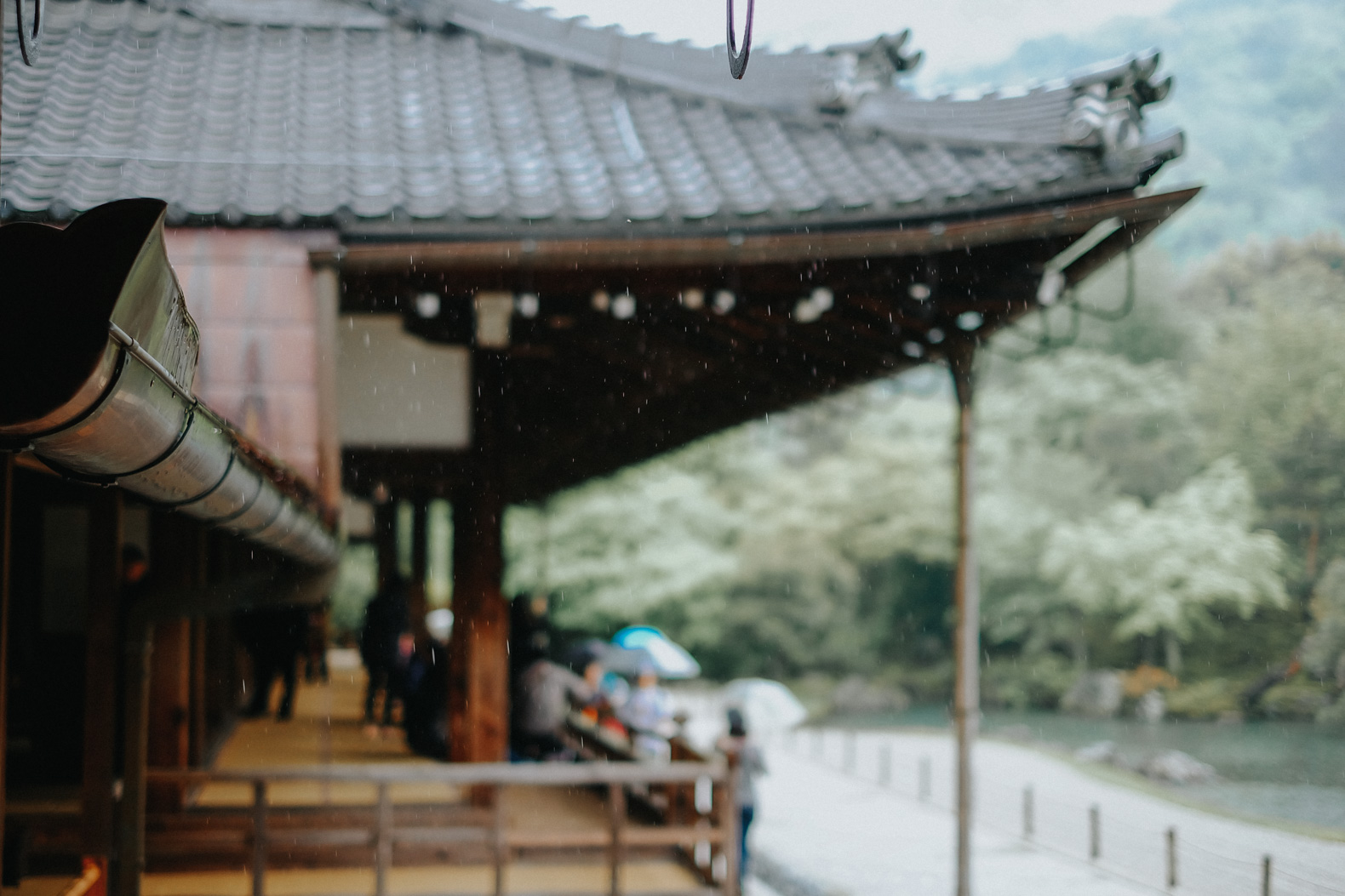
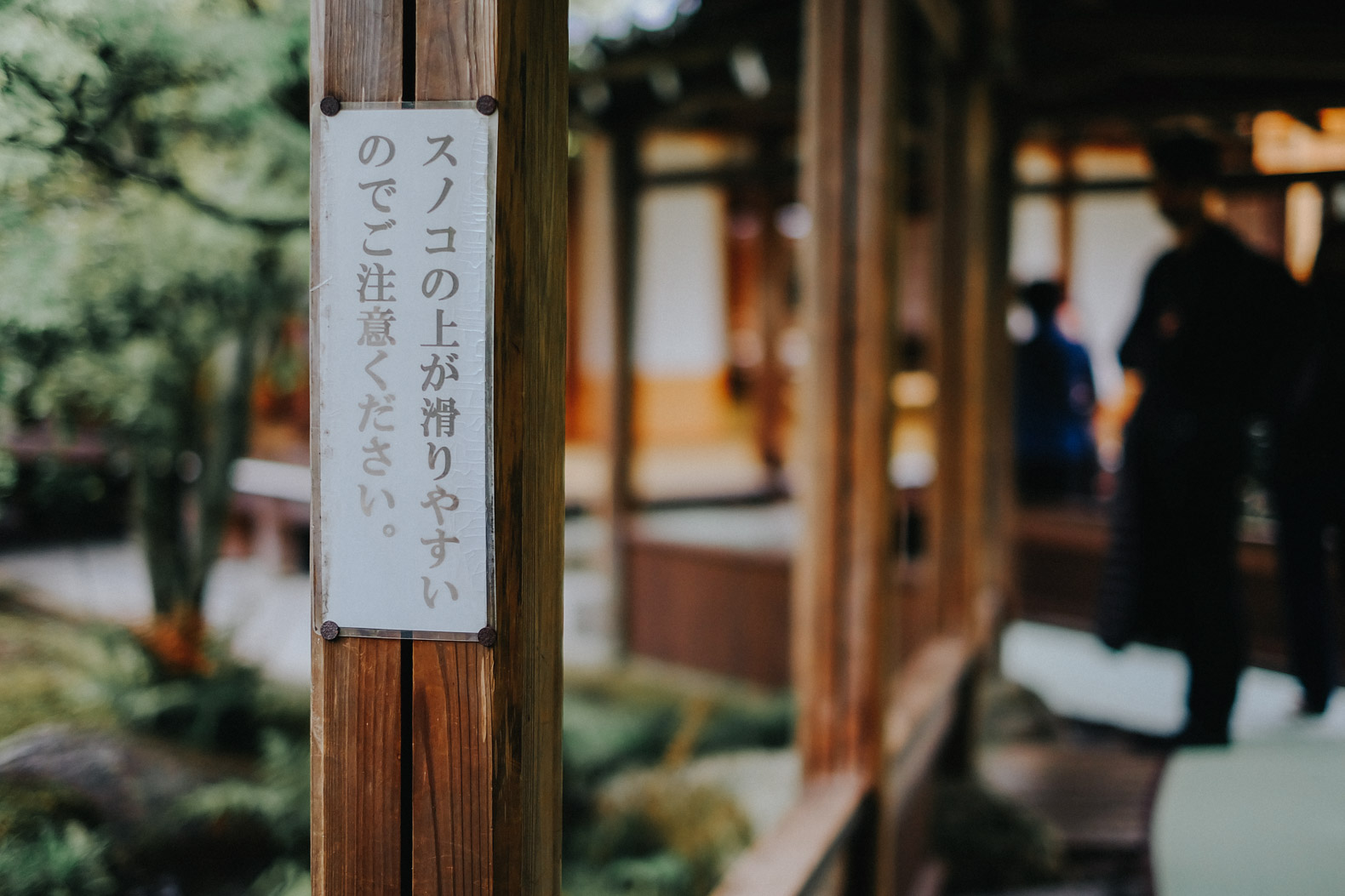
Here you’ll wander around the shrine. Starting with the building and its many exterior halls. Afterwards, venturing into the zen garden, which is the real star. There are many beautiful plants and flowers, such as the Japanese wisteria, which you never see outside Japan. They’re all labeled in English and Japanese. It was also here that I saw my first cherry blossom tree in Japan! Even though we were way too late for cherry blossoms in Kyoto, this late bloomer stuck around. It was pretty special to see it just chillin’ in the garden.
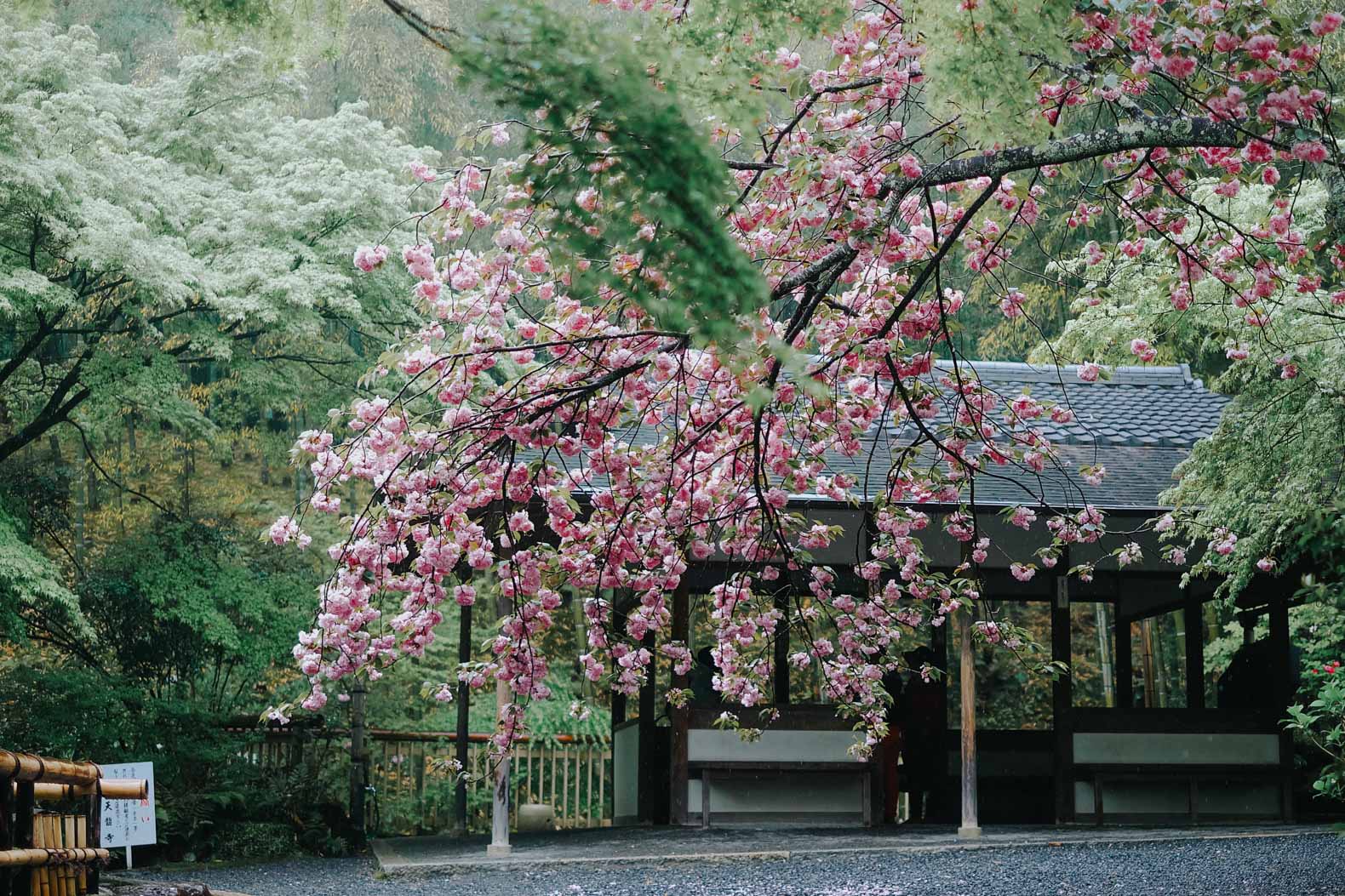
Tenryu-Ji is conveniently located right next to the Arashiyama bamboo forest . You can simply follow the signs and you’ll find yourself at its entrance.
Bamboo Forest
Let me be the first to tell you: this bamboo forest is kinda small. At least, I was expecting something much more massive! That said, it’s clearly one of the essential experiences to have in Kyoto so I wouldn’t pass it up. You’ll walk through in 10-15 minutes (depending on how determined you are to take a photo with no people in them). Be sure to bring a wide-angle camera lens in order to really capture the super tall bamboo. I was severely lacking one and my photos reveal that!
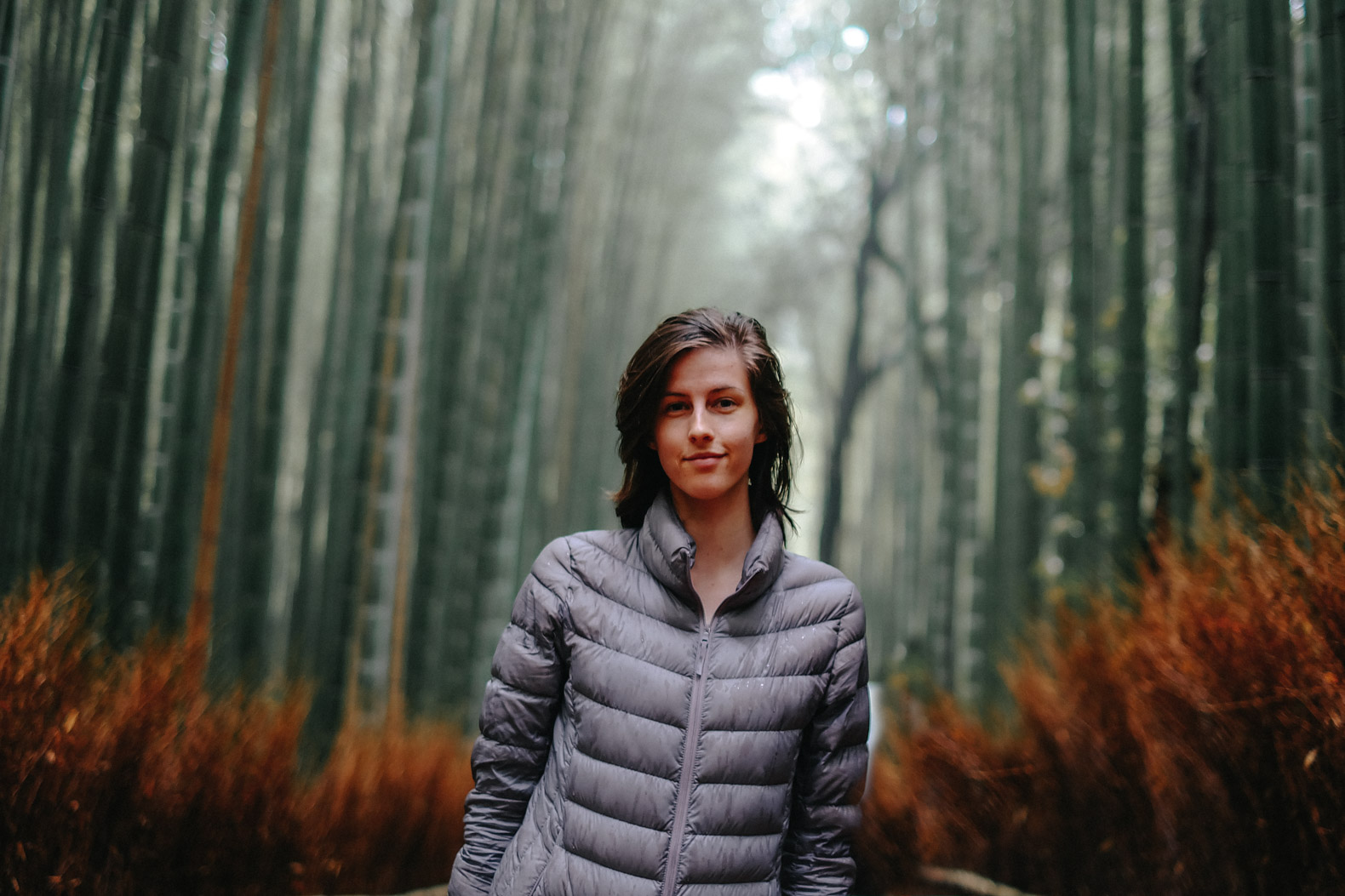
From the Bamboo forest, take the bus to the Golden Pavillion (Kinkaku-ji) . The bus ride takes a little under an hour and involves a transfer, but you’ll get to see a bit of the city of Kyoto on the way!
Golden Pavillion
The Golden Pavillion was probably the place where I realized: holey moley, there are a LOT of tourists in Japan. It was so incredibly crowded, and getting a decent view of the pavillion was pretty difficult! People just tend to bunch up at the best photo spots, taking what feels like a dozen pictures, and then sticking around to chat!
That said, the pavillion is obviously super impressive and beautiful. Reflected in the lake, it’s no wonder this is securely in the top 3 things to see in Kyoto! From the vantage point of the photo, you can wander around the pavillion’s surrounding gardens.
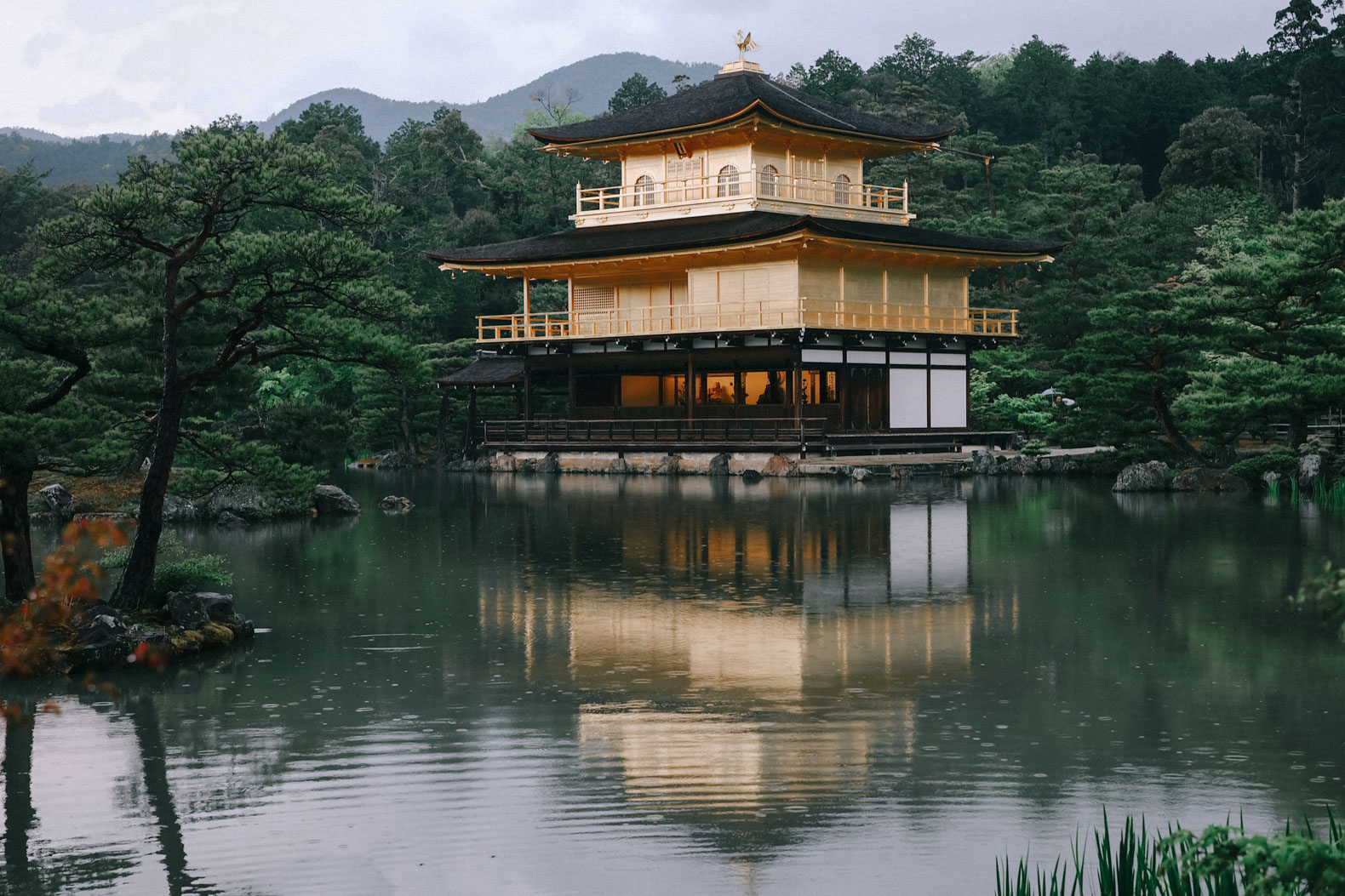
I also have to say that this is the place where I had my first ever Japanese-flavored ice cream. Gernot had the green matcha, and I took the black sesame. It was actually some of the best ice cream of the trip, so even though it’s expensive and touristy, it was perfect!
Which brings me to another thing about Japan: walking and eating is considered grossly uncivilized in Japan. We realized this was true, for the first time, when everyone was sitting in a room to eat their ice cream instead of walking around.

After the pavillion, it’s time to come back to the train station, grab your stuff, and check into the hotel or Airbnb where you’re staying. At this point, it’s well and duly time for dinner! Kyoto is famous for haute cuisine, so you can get an extremely fancy multi-course meal in Kyoto.
Enjoying the photos?
Follow along on Instagram!
Follow @notanomadblog for beautiful travel photography and stories of our journeys
Day 3: Enjoy the highlights of Kyoto
Today is the main day to discover Kyoto, so be sure to start early! Your most efficient path would be to start your morning at the Nishiki Market , take the bus to Gion , and then spend the day in East Kyoto in the Higashiyama area. After following that path and seeing tons of temples, shrines, and beautiful streets, you’ll end up close to Philosopher's Path , where you can walk a long the stream and enjoy some solitude!
Nishiki Market
If you’re set on trying all the weird foods you can find in Japan, Nishiki Market is an absolute goldmine. This relatively small market hall spans several streets, and offers snacks and produce which you can pick up to sample some traditional Japanese food. Here is where I tried tako tamago, the infamous candied baby octopus stuffed with a quail egg. It’s not for the faint of heart, but it’s the only place I saw it while in Japan!
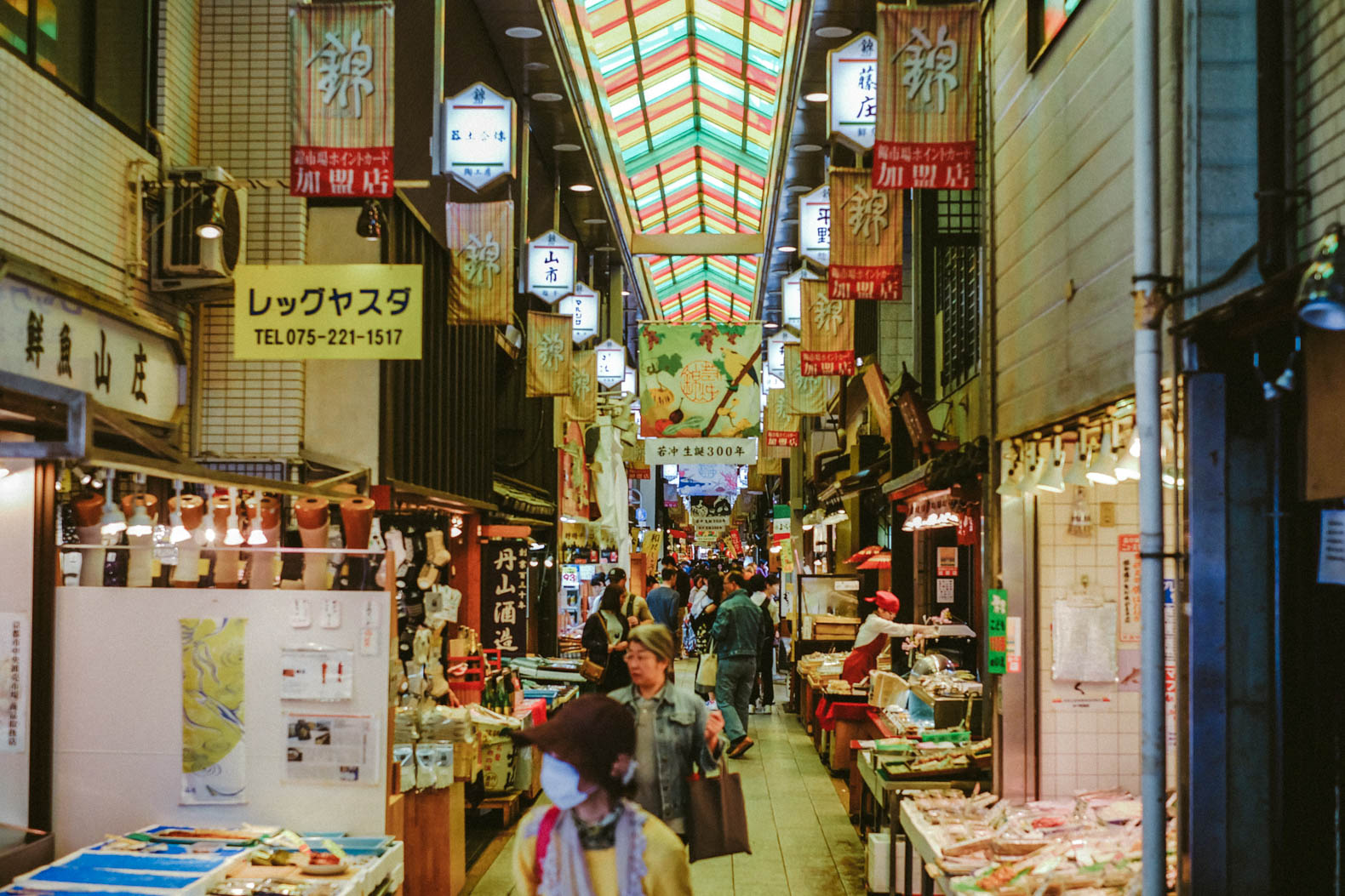
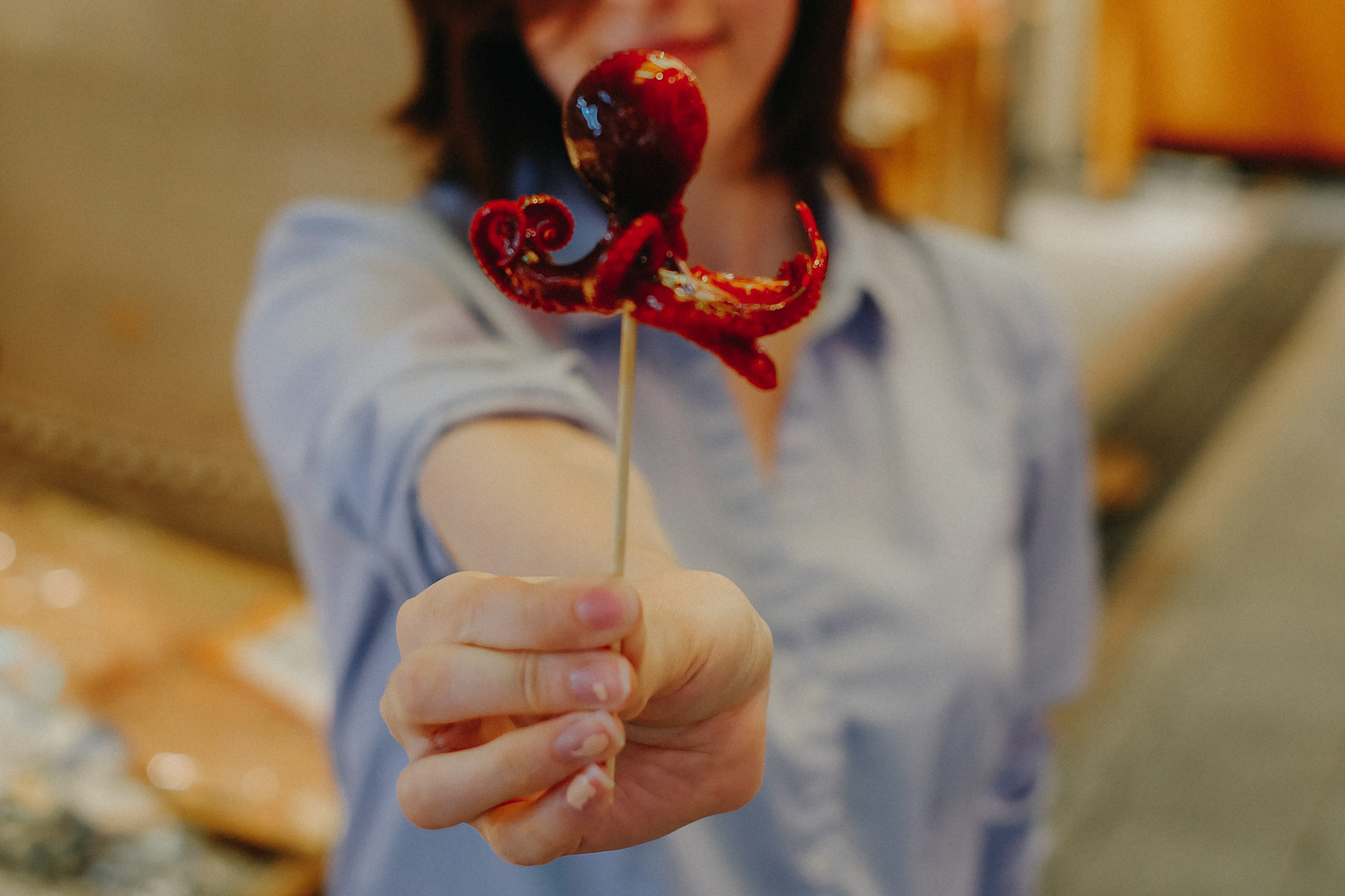
Gion
Gion is Kyoto’s famous geisha district. This is really the epicenter of geisha culture in Japan, and the place which has the most traditional rules regarding who can become a geisha. Outside Kyoto, there have been very few non-Japanese geisha, whereas in Kyoto it is completely not allowed.
Can you see the geisha (or more likely, geisha-in-training) hustle down the street in her red kimono?
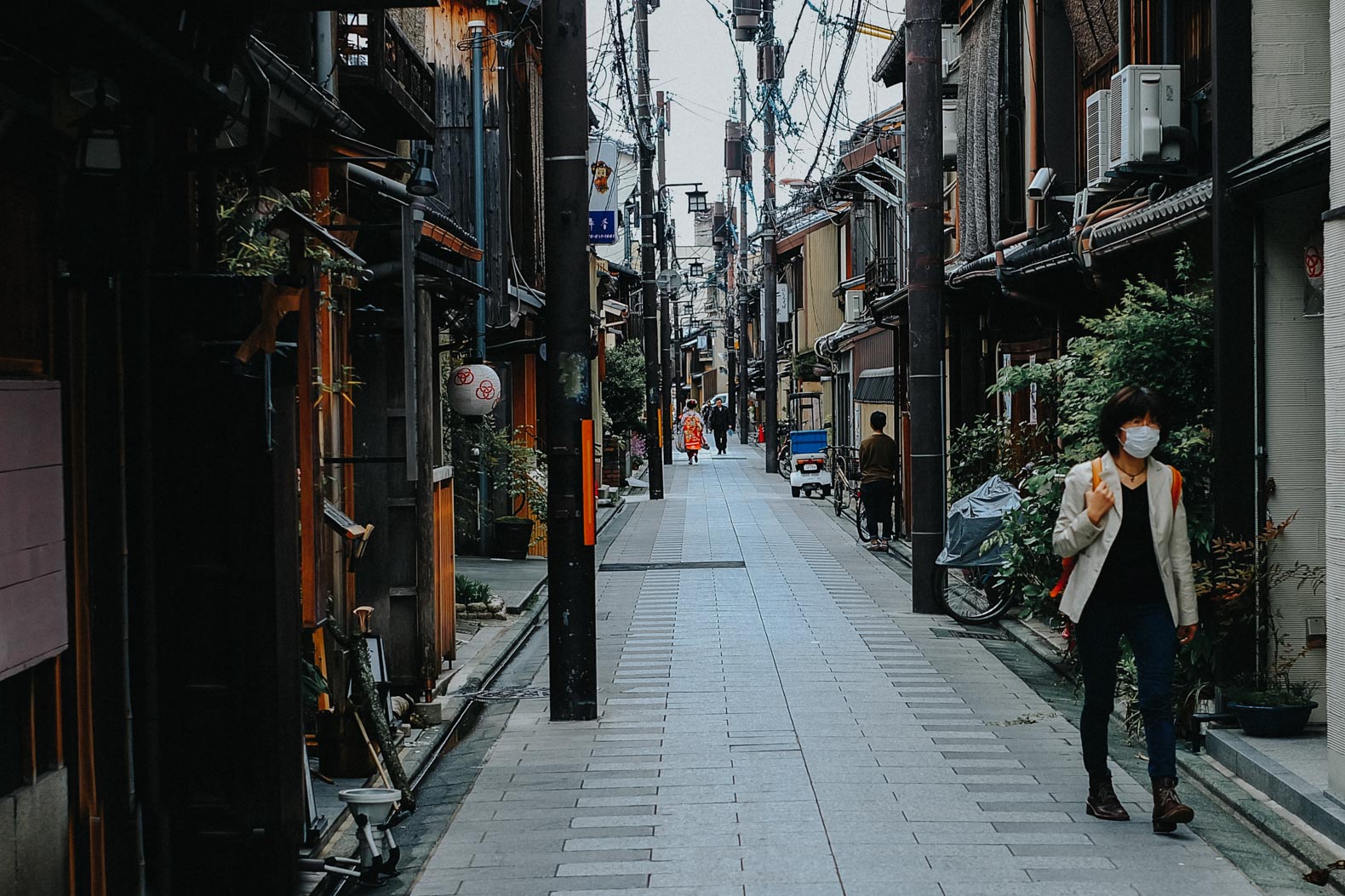
From Gion, we’ll walk towards the world famous hub of Kyoto’s best-known shrines and temples: Higashiyama . Southern Higashiyama is the place to be for the very best the area has to offer!
Higashiyama
Chances are if you’ve looked up photos of Kyoto, you’ve seen mostly pictures of Higashiyama. The rest of the city is very modern and, I must say, not so beautiful in comparison to the historic Higashiyama district.
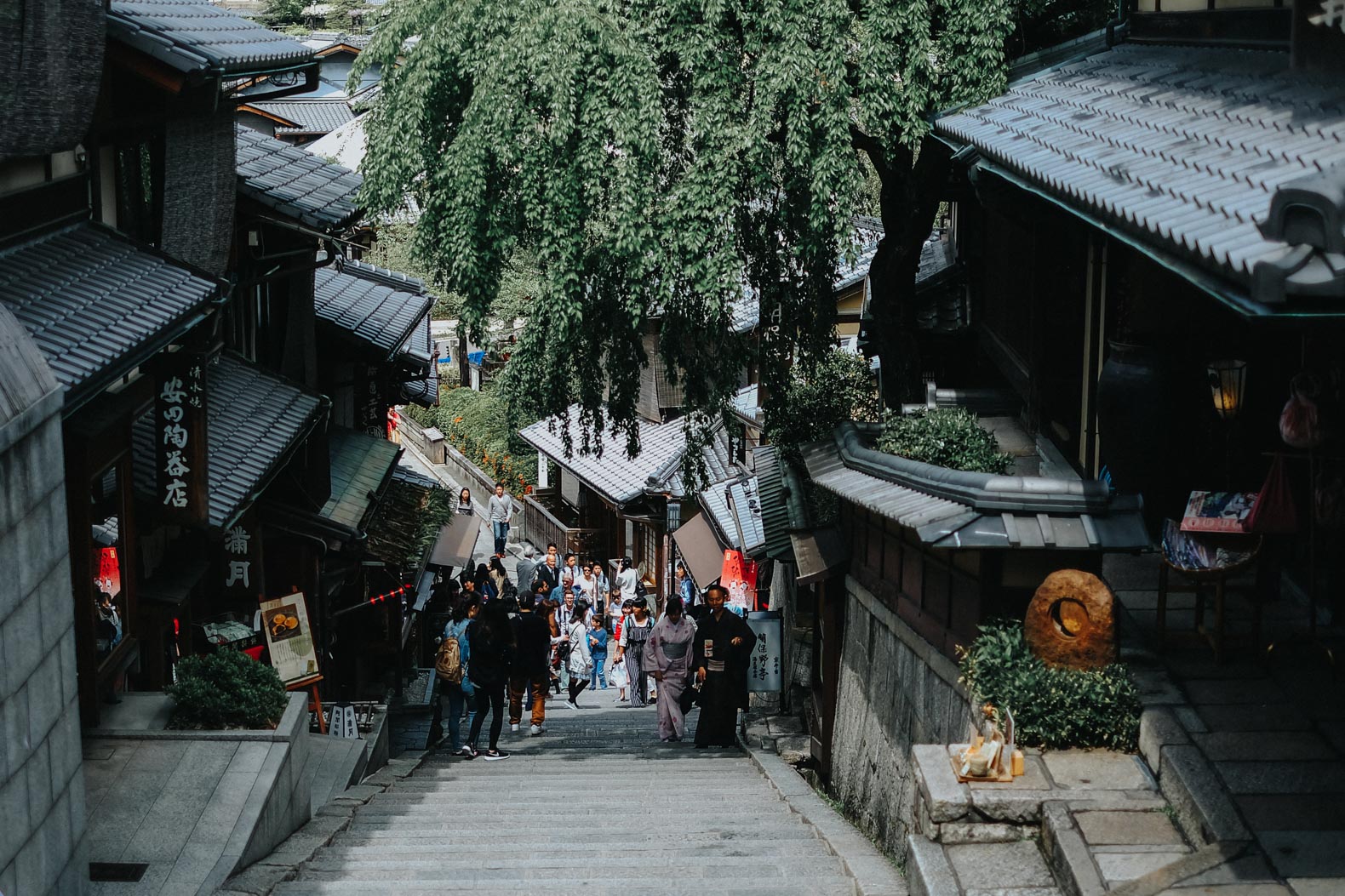
- Sannenzaka and Ninenzaka – The two most beautiful streets in Higashiyama. The former is the location of the famous stairs. Most of the houses have been converted into souvenir shops. It can get pretty crowded at mid-day, so come either first thing in the morning or around dusk for a less cramped experience.
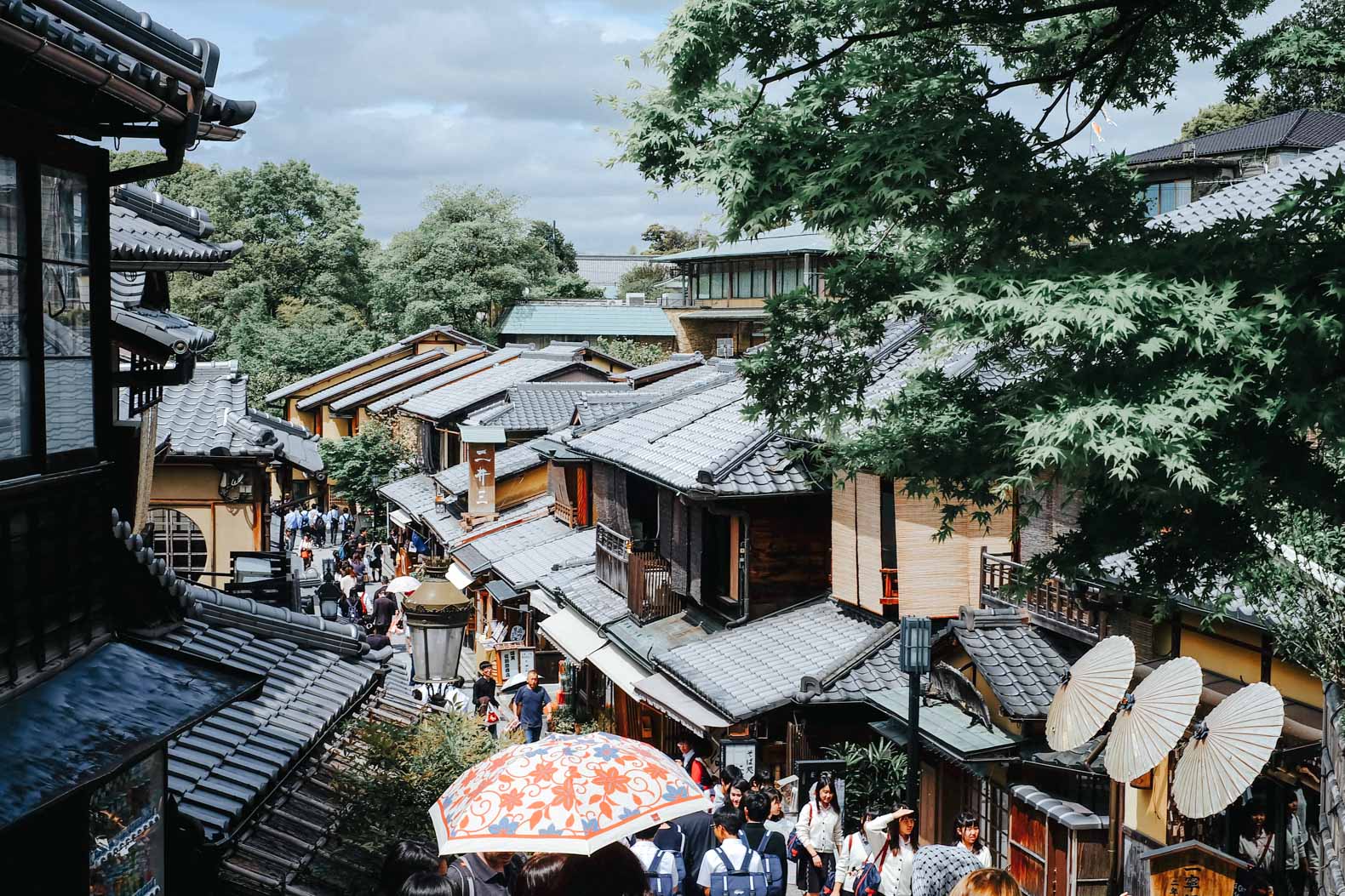
Besides the beautiful streets, there are loads of shrines and temples for you to visit. Here are a selection of my favorites:
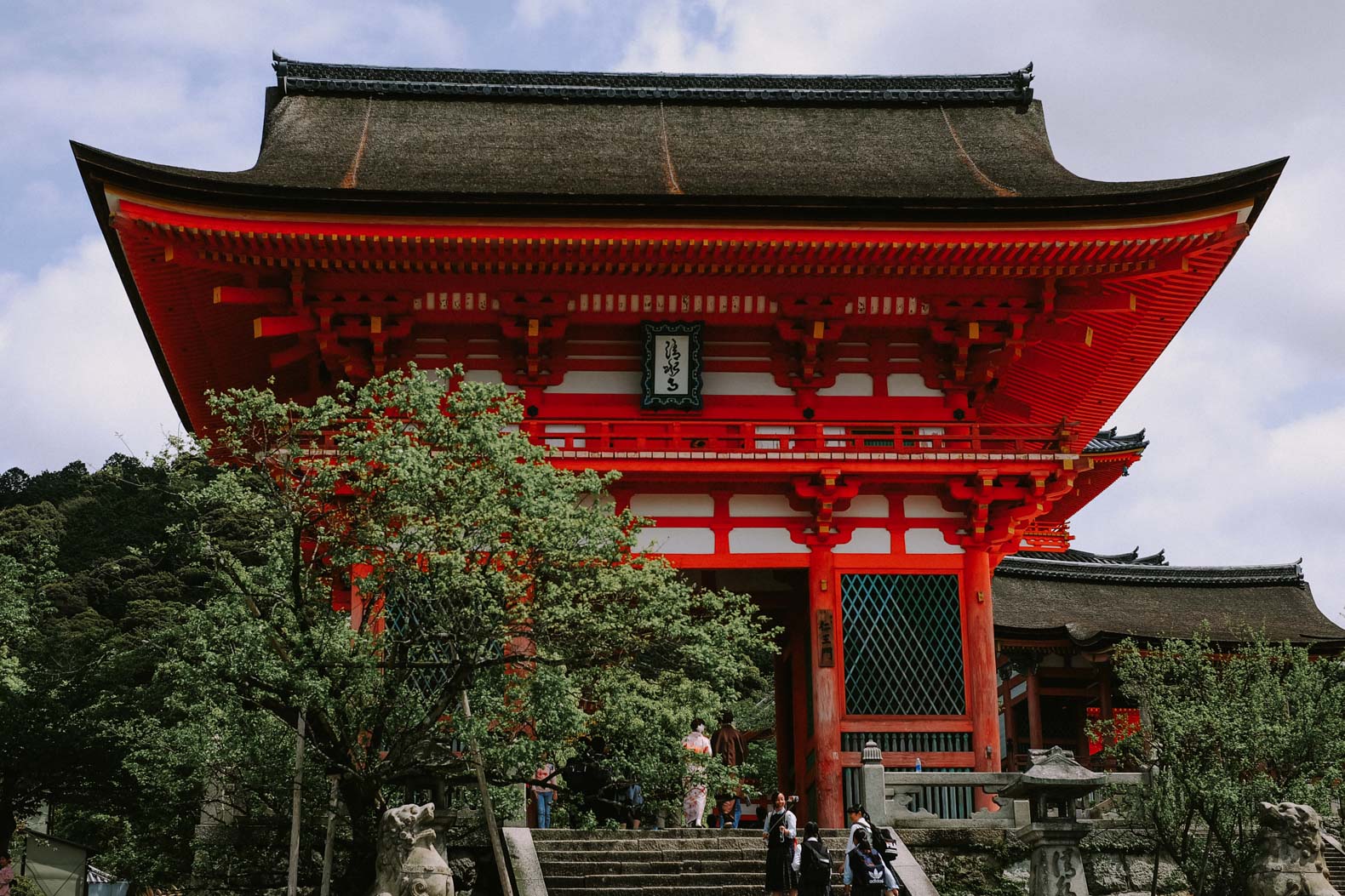
- Kyomizu-dera – This area is one of the busiest and best known in Kyoto for a reason. The view out over a sea of trees is hard to match – and in cherry blossom season, they’re also in bloom.
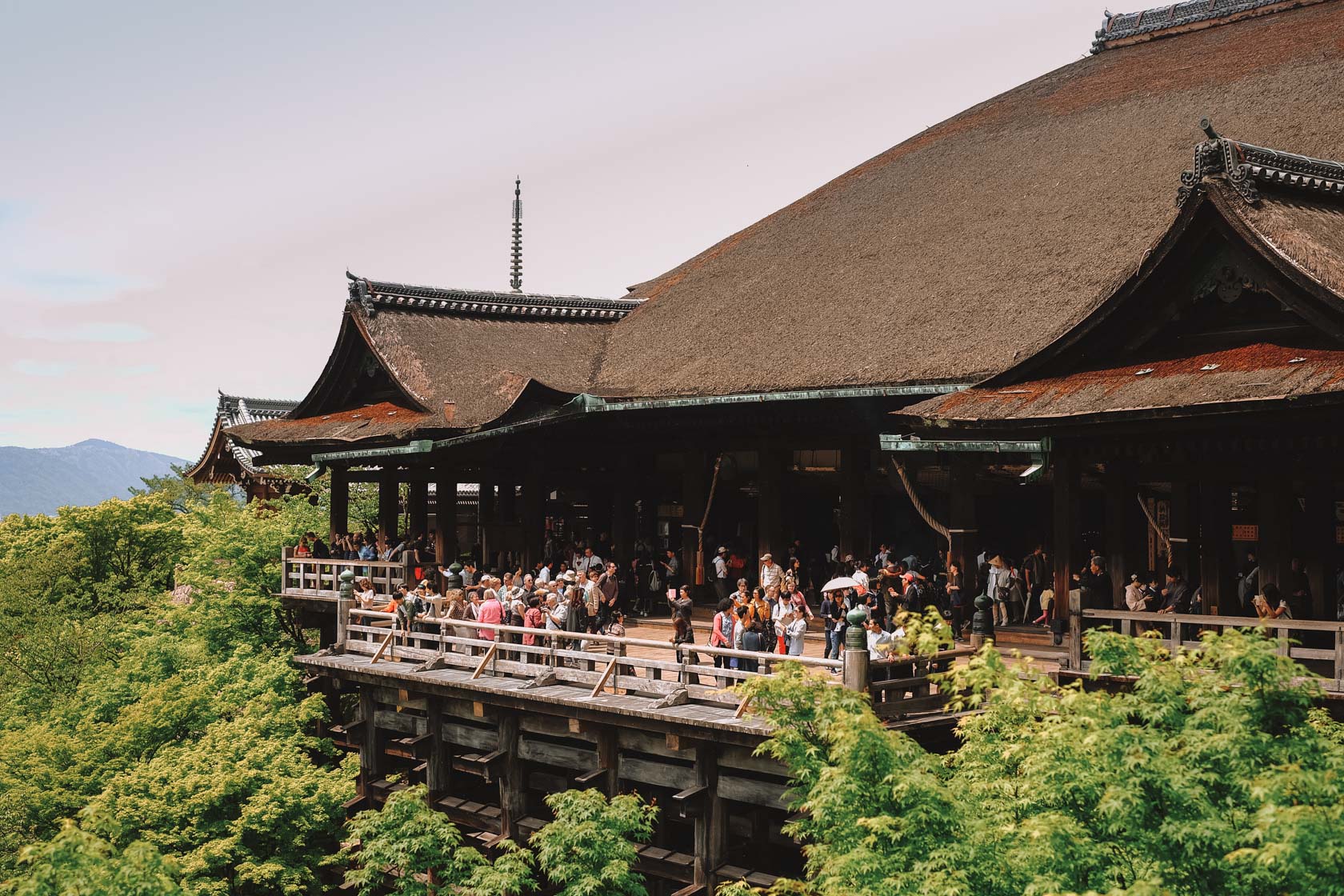
- Kodai-ji – This place has got a yuuuge zen garden. Come here for one of the nicest zen gardens you can find in Kyoto.
- Shoren-in – An oft-skipped but totally majestic Buddhist temple at the end of the Higashiyama route. Not crowded, gorgeous gardens, many winding corridors for you to explore. This place will make you want to live in your own Japanese villa one day! Read more about Shoren-in
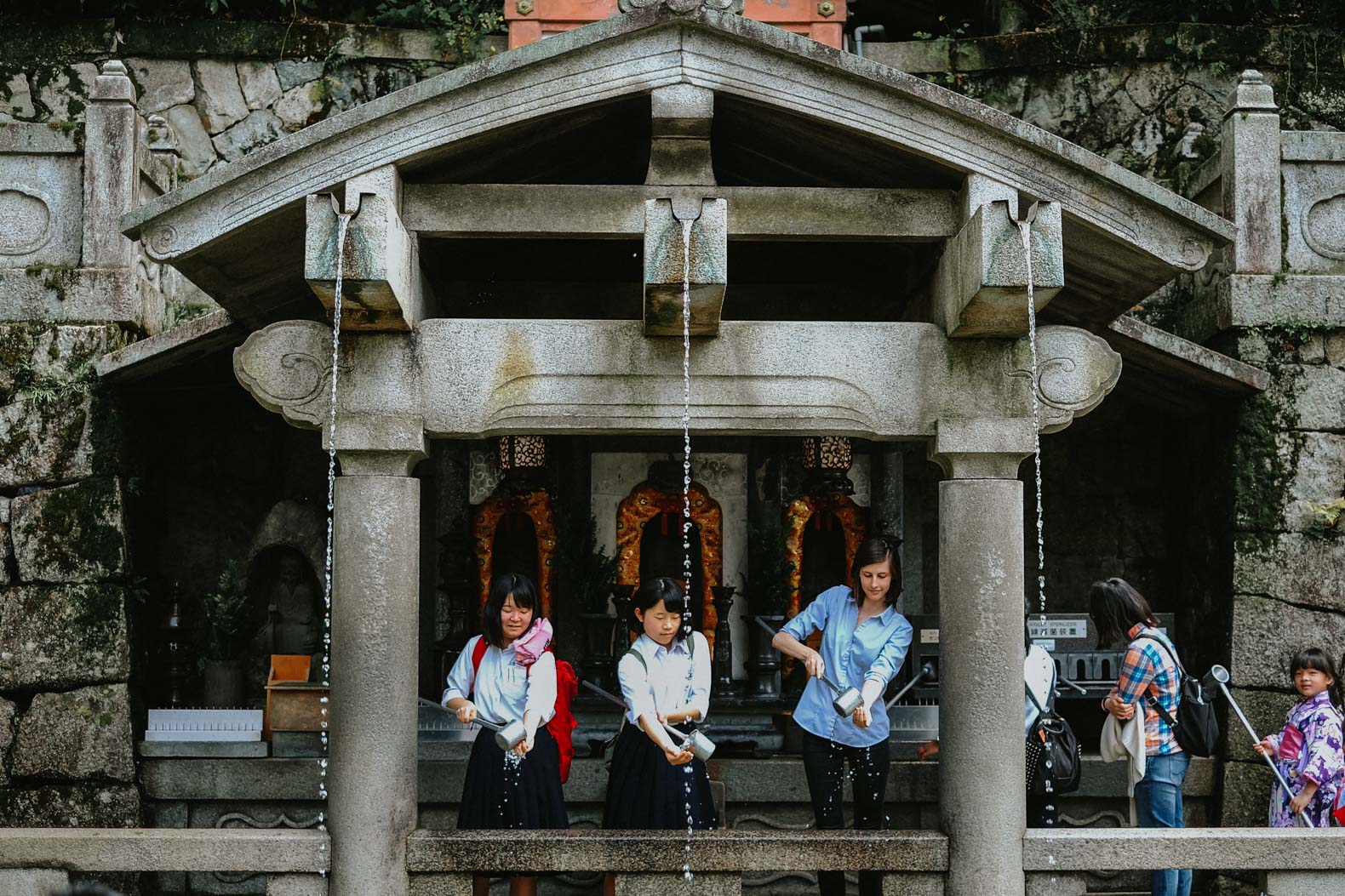
After Shoren-in, you can walk to the Philosopher’s Path (2.3 km, found on Google Maps as Tetsugaku-no-michi). This path along a narrow river is lined with cherry blossom trees in Spring. If you decide to talk this walk, you’ll end up near the Silver Pavillion . If you’ve still got energy, you can check it out! Otherwise, I recommend grabbing dinner at Asian Cample Foods Goya for a taste of delicious Okinawan food.
Day 4: Day trips to Fushimi Inari Shrine & Nara Deer Park
Imagine this: a capital city full of thousands of docile, free-ranging deer. If this sounds like your idea of paradise, you can’t miss Nara, Japan .
But first, it’s time to visit one of Japan’s most famous landmarks.
Fushimi Inari Shrine
These dizzying rows of red Torii are a photographer’s dream: if you can manage to capture an empty shot. I saw some of the thickest crowds of the whole trip when visiting these shrines, so be sure to give yourself some extra time if you want to focus on photos!
To get here, you’ll need to take the JR Line from Kyoto to Inari . After your time at the shrine, pop back on the train and continue to Nara.
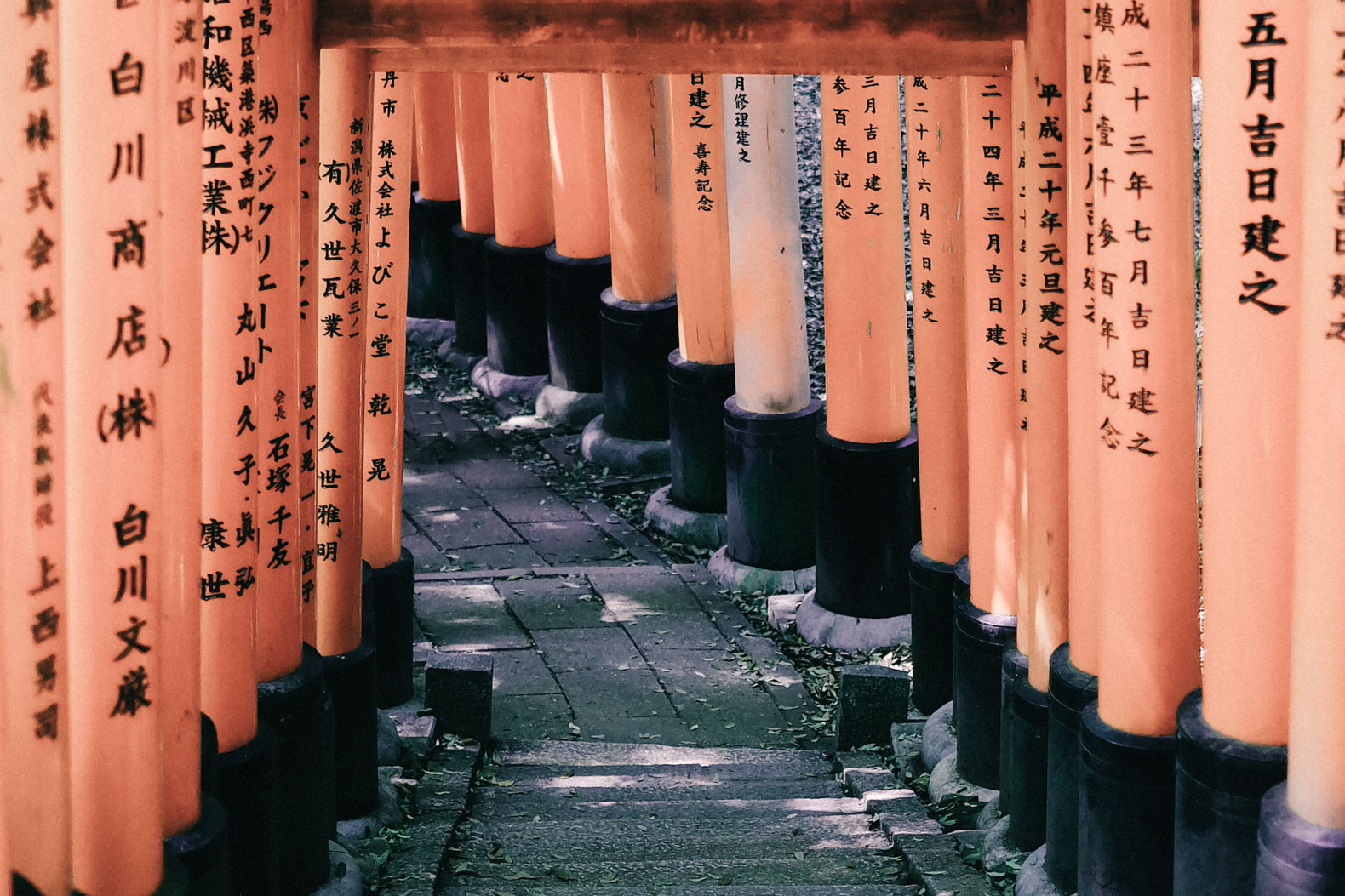
Nara
The very first capital of Japan, Nara is humble by today’s standards. The city center is small, and the population a mere 360,000 inhabitants. But don’t let that fool you: Nara has some of the most unique experiences to offer on the Japanese itinerary:
- Todai-ji – The world’s largest wooden building. Inside, a massive Buddha. You can try to climb through its nostril (a sign of good fortune).
- Isui-en – One of the best gardens we saw in Japan. That, plus a personal tour from a member of the staff, made the story behind the garden really come alive.
- Nara Park – Over 1,200 free roaming deer. Keep your map close, they will eat anything. Note that if you buy biscuits in Nara, those are for the deer, not you.
Sadly my camera died in Nara so I have very few photos to share. You’ll have to see for yourself!
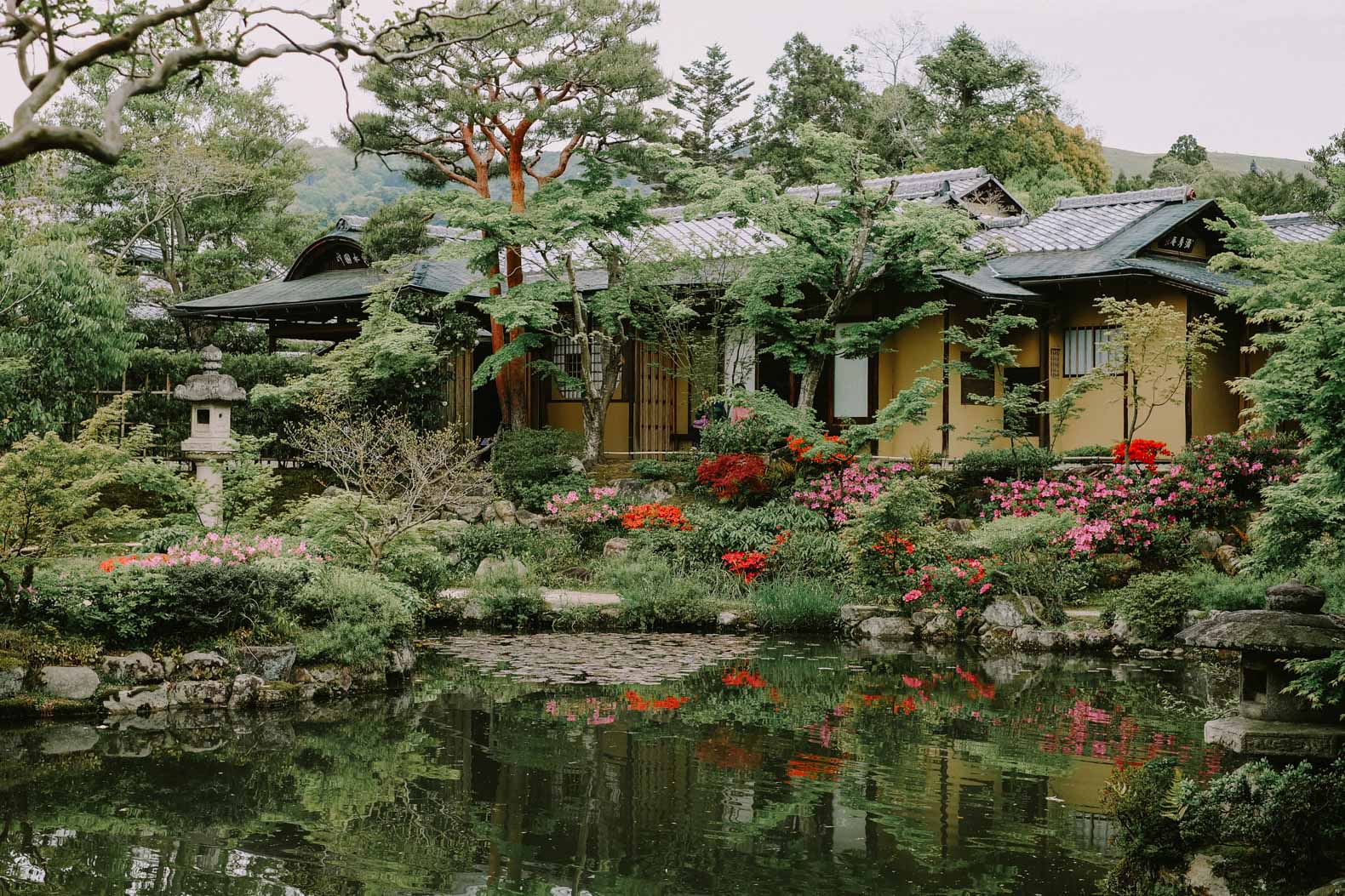
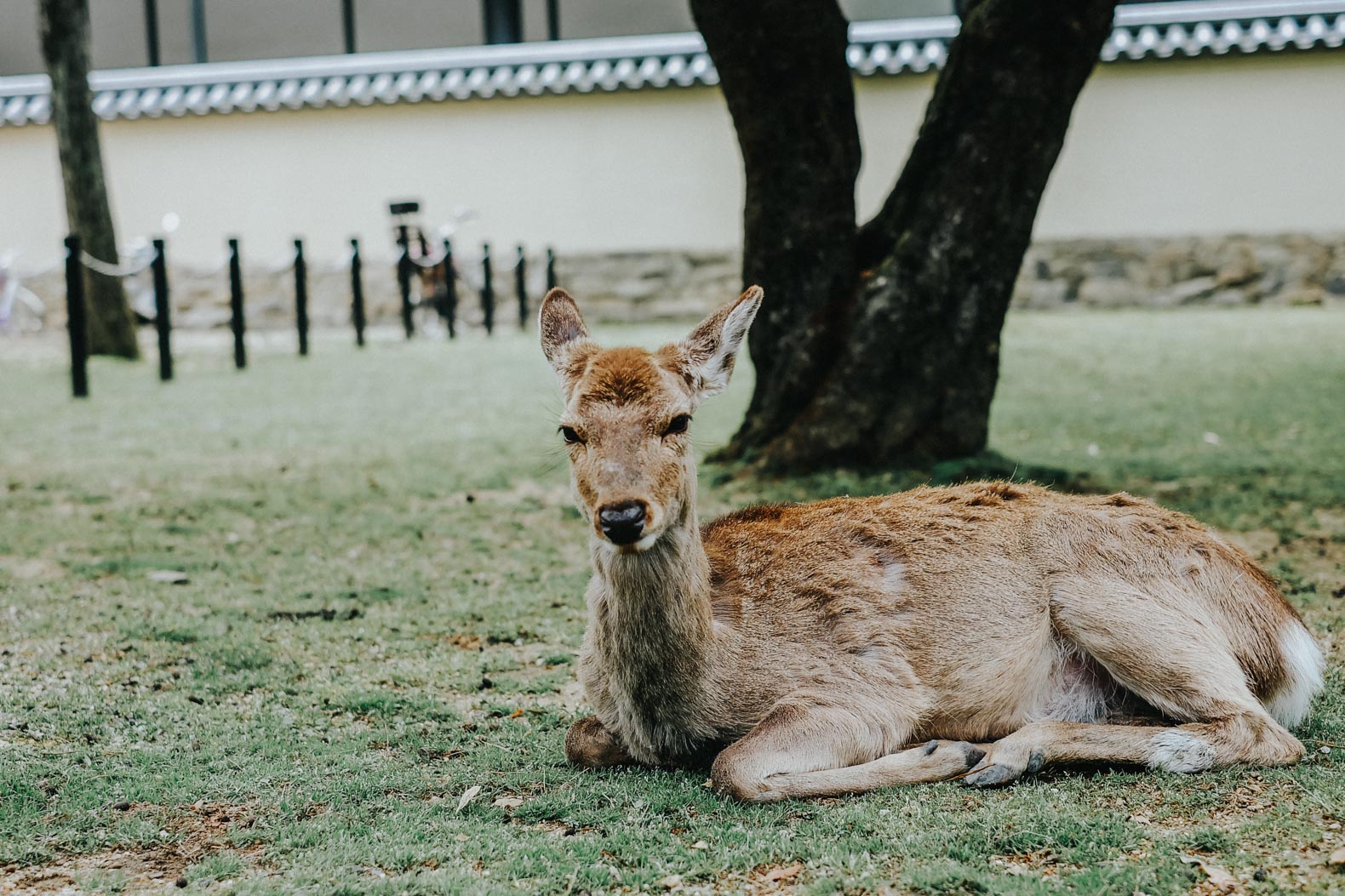
Left, Isui-en Garden, Right, Deer 😂
Plan a solid half-day for Nara, if not more. We spent a lot of time walking around Nara Park, there is a lot to explore and hiking paths if you want to speak more time walking around!
Spend your last night in Kyoto and wake up early to catch the train down to the southernmost post on our itinerary: Hiroshima .
Day 5: Remember the history of Hiroshima
I will start by saying that Hiroshima is simply not a beautiful city. It was hastily rebuilt after the tragic events of World War II and the destruction of the atomic bomb. As a result, you won’t find charming alleys or old merchant districts. Instead, you come to Hiroshima to get a glimpse into the lives of the people who both died and survived as a result of the bomb, and the effects it’s had on the community.
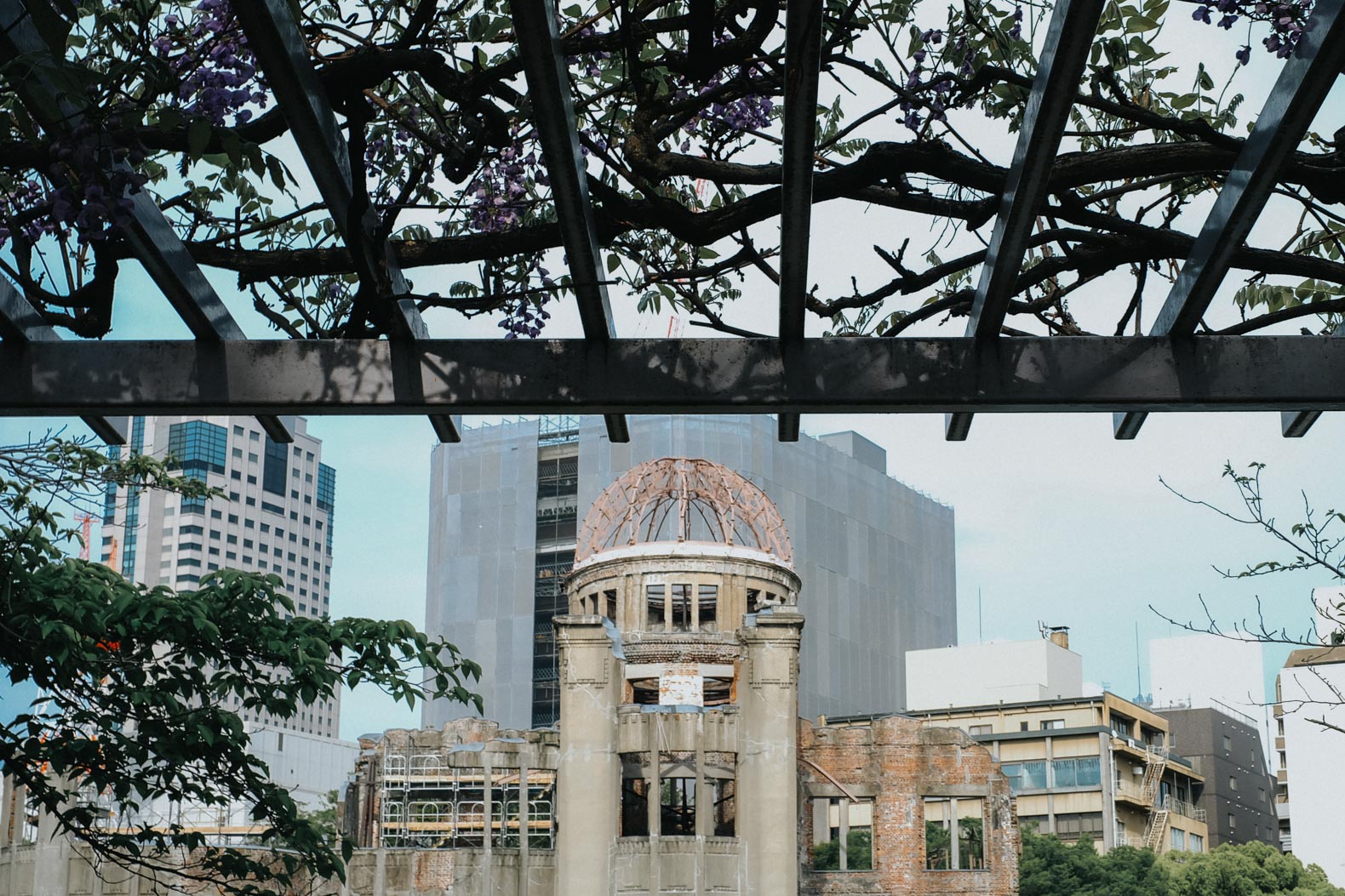
The Atomic Bomb Dome
This is the singular building that was left standing after the atomic bomb devastated Hiroshima. You should absolutely visit the Hiroshima Peace Memorial Museum . The museum really toes the line between giving a realistic look at the consquences of the bomb, while also shielding you away from some of the more gruesome details (meaning, it is still suitable for children).

Hiroshima Castle
This is the first castle on our trip to Japan, and to be honest, it’s a bit underwhelming. The interior has been completely gutted to turn into a museum (on the up-side: you can get your photo taken in a samurai outfit!). Don’t worry, we’ll end up at the mother of all Japanese castles later.
Here are some more ideas for things to do while you’re in Hiroshima, after you’ve visited the museum, the Peace Park, and seen the flame that remains lit until the last nuclear weapons on earth are destroyed.
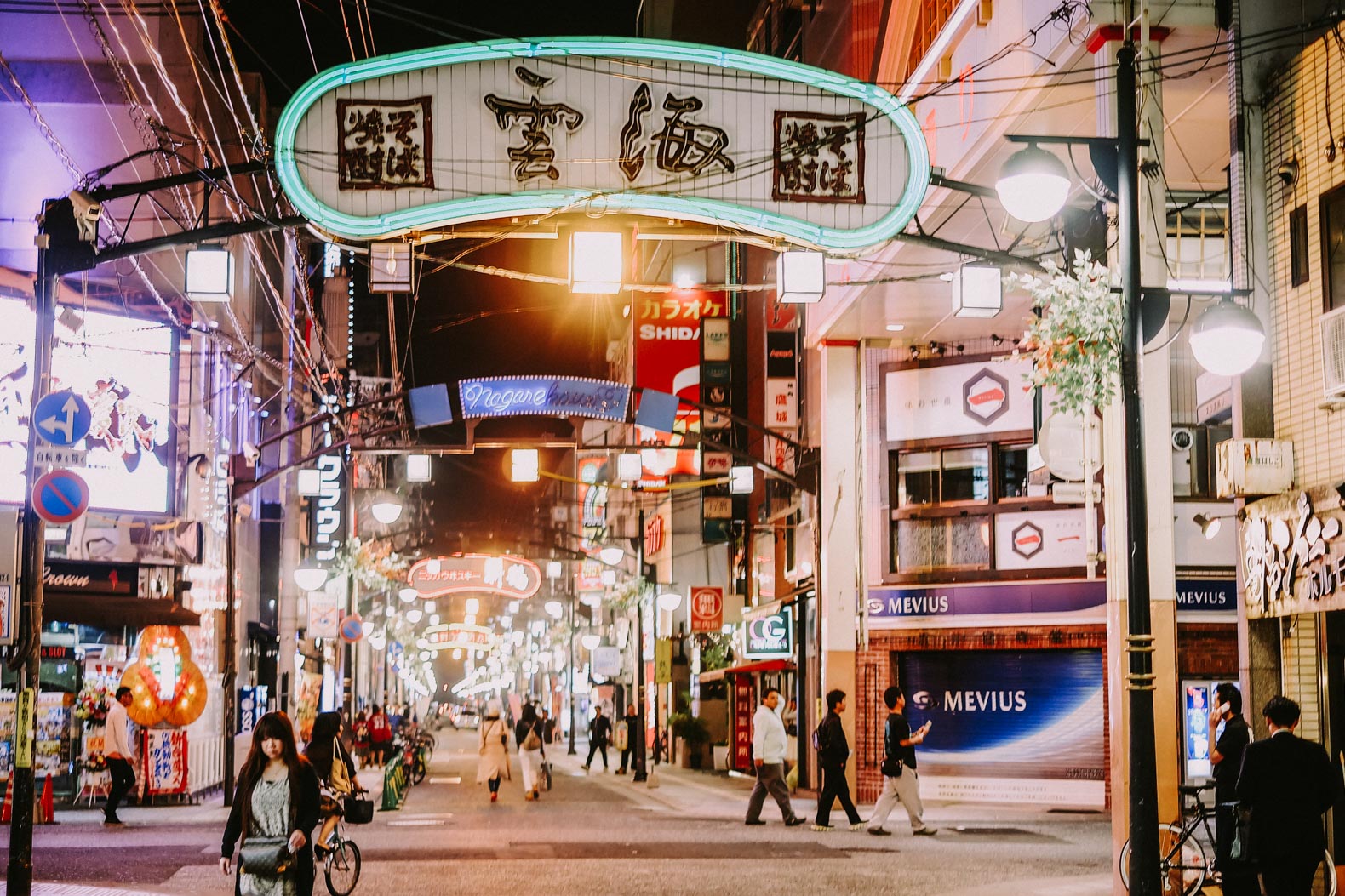
Things to do in Hiroshima
- Hiroshima is the birthplace of
<a href=”/regional-cuisine-street-food-to-try-in-japan/#okonomiyaki” onclick="ga(‘send’, ‘event’, ‘Affiliate Link’, ‘Click’, event.target.getAttribute(‘href’));”
target=”_blank">Okonomiyaki , and the city does it like nowhere else. Combine that with
<a href=”/regional-cuisine-street-food-to-try-in-japan/#oysters” onclick="ga(‘send’, ‘event’, ‘Affiliate Link’, ‘Click’, event.target.getAttribute(‘href’));”
target=”_blank">oysters
and you’re eating the most quintessential regional dish. Be sure to visit Okonomi-mura (Okonomiyaki Village) for the epicenter of Oko-eating in the city.
- Hiroshima is also famous for its nightlife. If you’re looking for a wild night, Hiroshima might just be the place to have it.
- Mitaki-dera is a very special and unique shrine in the northwest of Hiroshima.
- Ride the vintage tram. Hiroshima prides itself on having a super old-fashioned tram system, complete with cars from the 70s! Blast from the past, yoo.
Spend the night in Hiroshima and wake up early, we’re going to Miyajima!
Day 6: Miyajima, Himeji, & Osaka
This is our crazy day. Start in Hiroshima, take the JR Ferry to Miyajima. Spend some time on the island, catch the ferry back, connect to a train to Himeji. Spend the rest of the day exploring the castle and grounds until it closes. Wind up in Osaka to start binging on street food.
Are you ready?
Miyajima
I’ll start with this preface: If you’re not set on exploring Hiroshima by night, I’d encourage you to spend the night on Miyajima instead. This island in Hiroshima bay is home to one of the top 3 national sights in Japan, and is one of the most visited locations in the entire country. You can beat the first boat ride in and have a Miyajima at sunrise all to yourself!
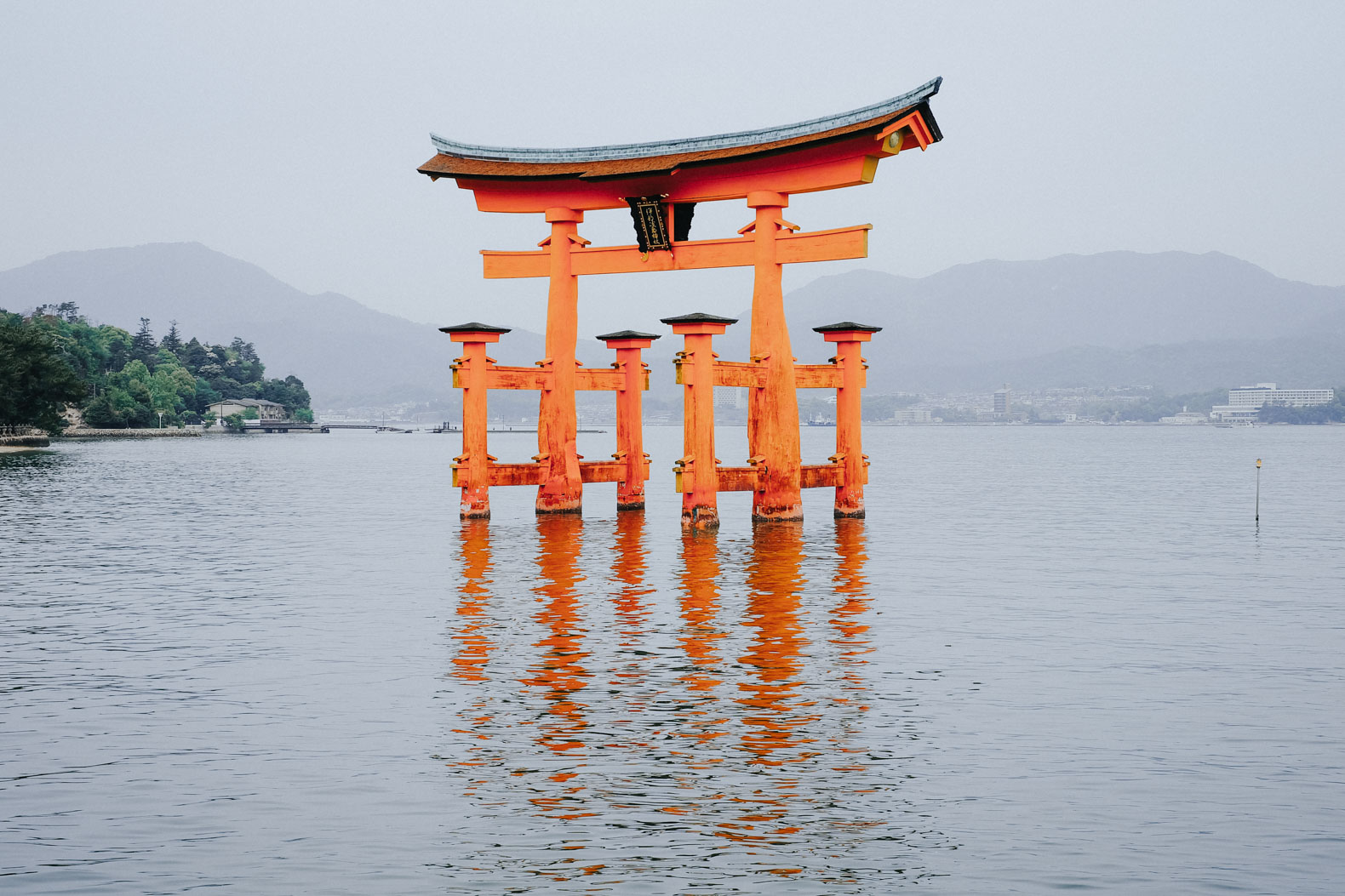
Things to know about visiting Miyajima
I’ve already written a bit about things to do on Miyajima besides seeing the shrine so I won’t duplicate the information here. Here is a quick summary of things you need to know when visiting Miyajima:
- Don’t take the “scenic boat ride” around Hiroshima’s harbor, just go for the JR Ferry. As I mentioned, Hiroshima is not very scenic and its harbor is no exception. It costs more and takes longer.
- Take the ropeline to the top of the mountain for a view over the bay. Along the way you’ll see many treasures ^__^
- If you’re collecting souvenirs, buy a rice paddle in Miyajima. It’s the essential Miyajima souvenir!
- Skip paying to go out onto the dock in front of the shrine – the best photos can be taken from the shore anyways, and you can just walk around to the other side without paying.
- Be sure to plan your visit in tune with high tide! At low tide, the water recedes and you miss the “floating Torii” illusion.
Did I mention there are also deer on Miyajima? They’re more aggressive than the Nara variety. Guard your map!
Himeji
After taking the ferry back from Miyajima to the mainland (you want the Hiroden-miyajima-guchi station), hop on the train to Himeji. We’ll spend the rest of the day here until the castle closes at 5PM. Upon arrival, lock your backpack in a coin locker and catch the bus to the castle from the train station.
For the uninitiated: Himeji Castle is perhaps Japan’s most famous and best-preserved castle. It’s meant to resemble a bird in flight, and is known as the “White Heron Castle.” It has survived extensive bombing of the surrounding city during World War II as well as a massive earthquake in the mid-nineties. Himeji is here to stay.
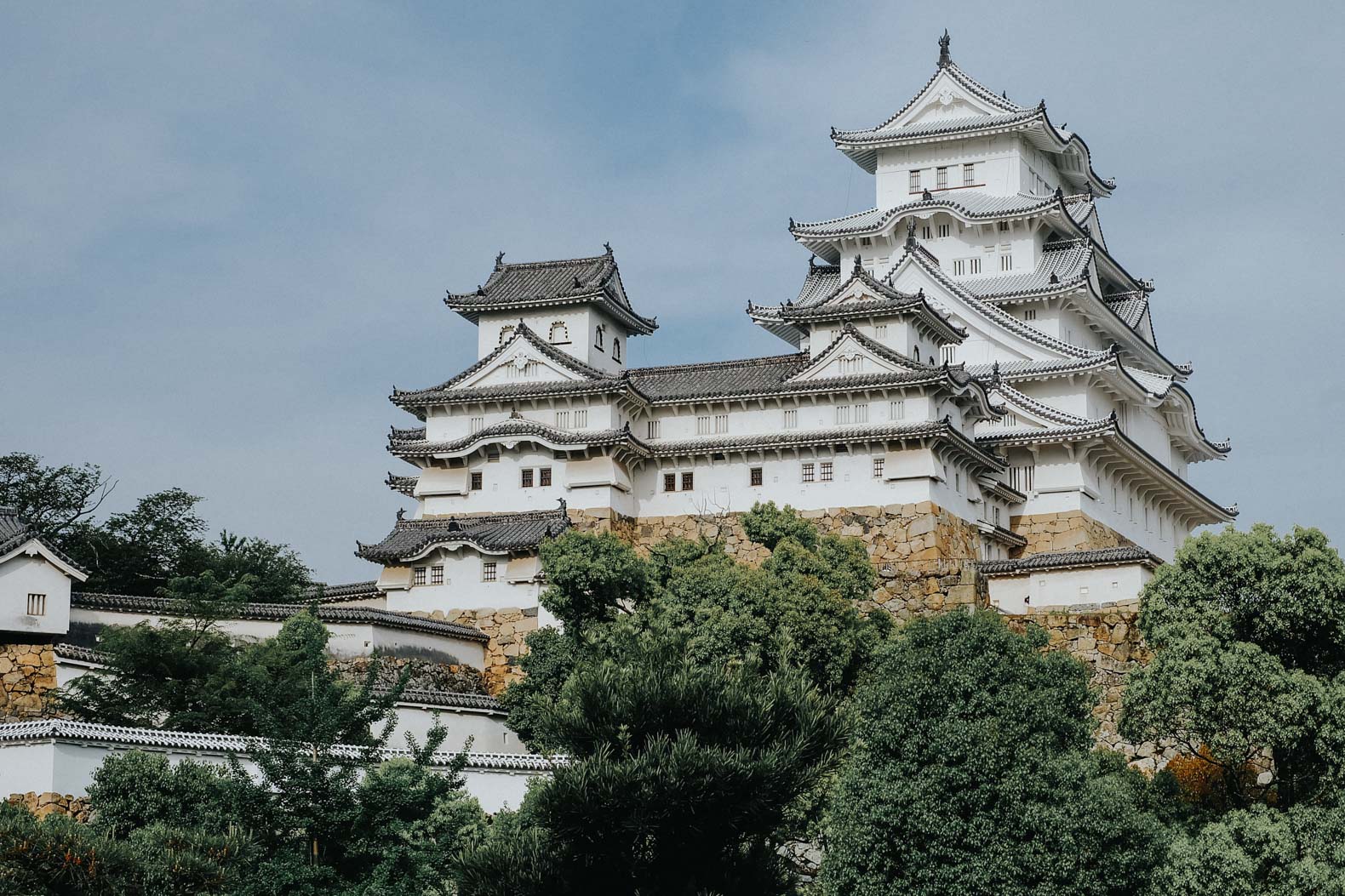
If you have time, there are also samurai quarters to explore in the vicinity. You can buy a combination ticket for the castle and the quarters at the entrance. Unfortunately we couldn’t make time to see those before leaving, but they’re reportedly really interesting.
Important! Check the train times to make sure you’ll be able to catch a train to Osaka shortly after the castle closes.
Osaka
If there’s one place I feel I didn’t get enough time, I’d have to say it was Osaka. It’s got such a cool, alternative vibe when compared to high-heels-and-Prada Tokyo. It’s most famous for its street food, and it considered the foodie capital of Japan. If you’re here to eat everything in sight, Osaka is a wonderfully dangerous place to end up.
Where to stay in Osaka
If you have just one night in Osaka, there’s no other place to stay than Dotonbori . The neighborhood’s eponymous street is THE definition of the loud and chaotic Japan. The first thing that happens as you approach is that you smell SO much food. Street vendors cook takoyaki in giant, metal trays filled with fried balls of dough and minced squid. If you don’t come hungry to this street, you are making a huge mistake!

Besides food, this street is also famous for its moving, animal billboards. Cows, crabs, and pufferfish are just a few of the giant electonic puppets looming over the heads of pedestrians.

Things to do in Osaka
- See the famous Glico Man sign at Ebusu-bashi bridge. This is perhaps the most recognizable landmark in Osaka (that’s right: a giant illminated sign).
- Go to the Osaka Castle , one of the prettiest in Japan with its teal and gold coloring.
- Eat Honetsuki-dori! This was one of my most memorable meals in Japan. You basically get two choices of chicken (young chicken or old chicken) and then you can choose from sides, which are mostly also chicken.
- As mentioned, eat the takoyaki!
- If you’re feeling adventurous (and spendy), you can splurge on a plate of Fugu (pufferfish, which can be deadly if not cooked by a licensed expert).
- Osaka also has a huge aquarium, which you can visit if you decide to spend more than a night in this city.
Don’t get too comfortable: after a lazy breakfast and a sobering view of Osaka by day, it’s off for a culture shock on top of your existing culture shock. We go from always-on Osaka to sleepy Takayama in the Japan alps.
Day 7: Take the train to Takayam in the Japan Alps
You read me right: Japan has got its very own range of alps. It contains three mountain ranges: Akaishi mountains, Kiso mountains, and Hida mountains. We’re going to the latter, to the Hida region.
Absolutely do not forget to book the Wide View train for your ride through the mountains! You’ll get a train with enormous glass windows, perfect for day dreaming about your imaginary life in the Japanese countryside a la My neighbor Totoro.
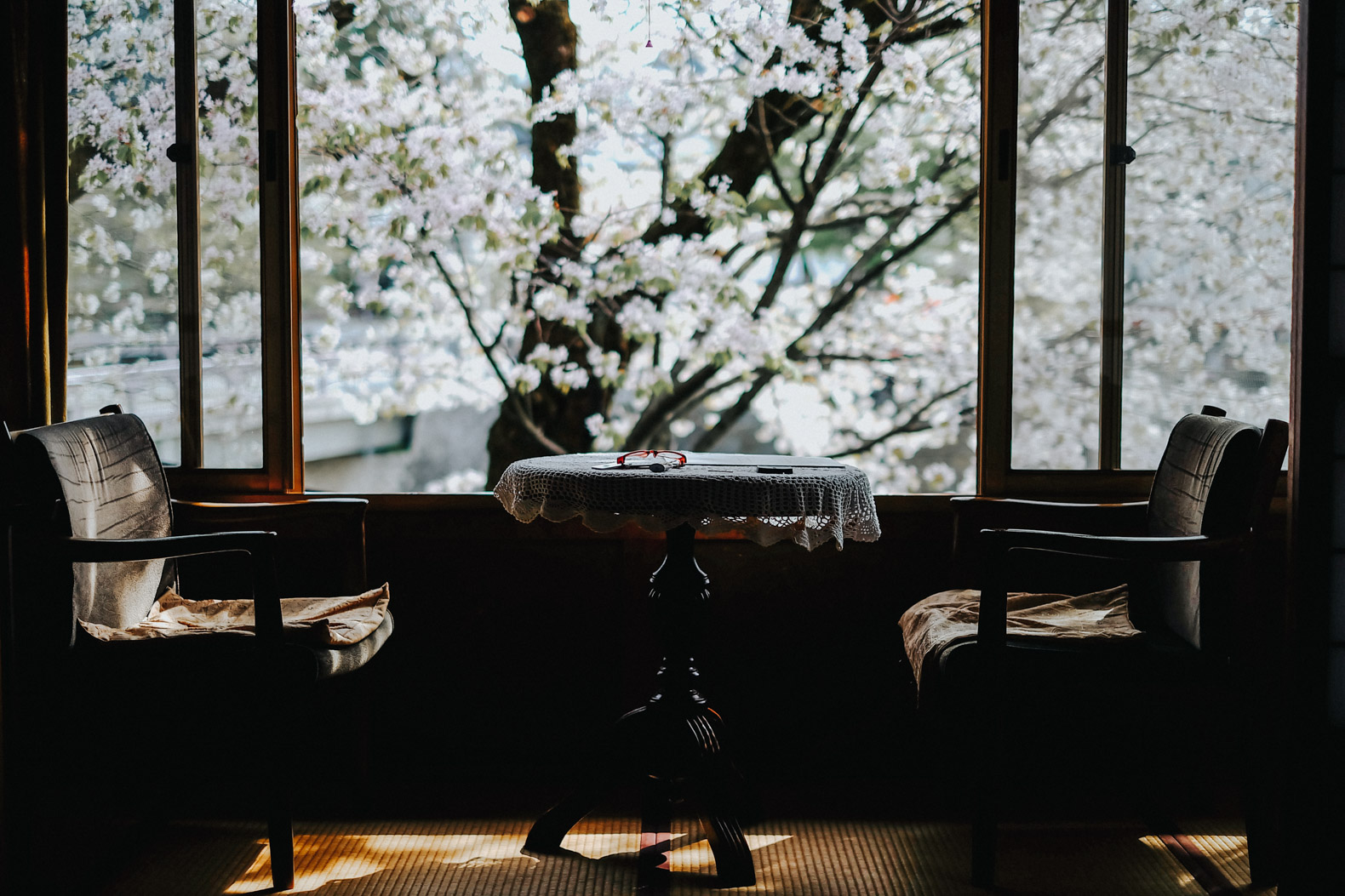
For us, Takayama seemed the perfect place to check in to a traditional Japanese inn, called Ryokan. This has got to be one of the top experiences to try in Japan, and if you’re not in a big city like Kyoto, you can do it for a bit of a better price.
Why you should stay in a Ryokan in Japan
- You get to dress up in Japanese dress. You can put on a Yakuta (a summer kimono) while you eat your delicious, amazing, unidentifiable Japanese breakfast.
- Experience Japanese hospitality. Our hosts were so kind and hilarious. At times it was a challenge to communicate, but with patience and humor anything is possible.
- Onsen minus public nudity. If you aren’t familiar with the Japanese concept of onsen, it’s basically a super hot public bath where head-to-toe nudity is mandatory. You shower off before getting in, and they’re divided by gender. Our ryokan had a private onsen you could visit with your partner. It’s awesomeeee.
Be sure to consider Sumiyoshi Ryokan when you go to Takayama! Room rates start around 150 EUR so it’s not cheap, but it’s absolutely going to be the most memorable place you stay on your trip!
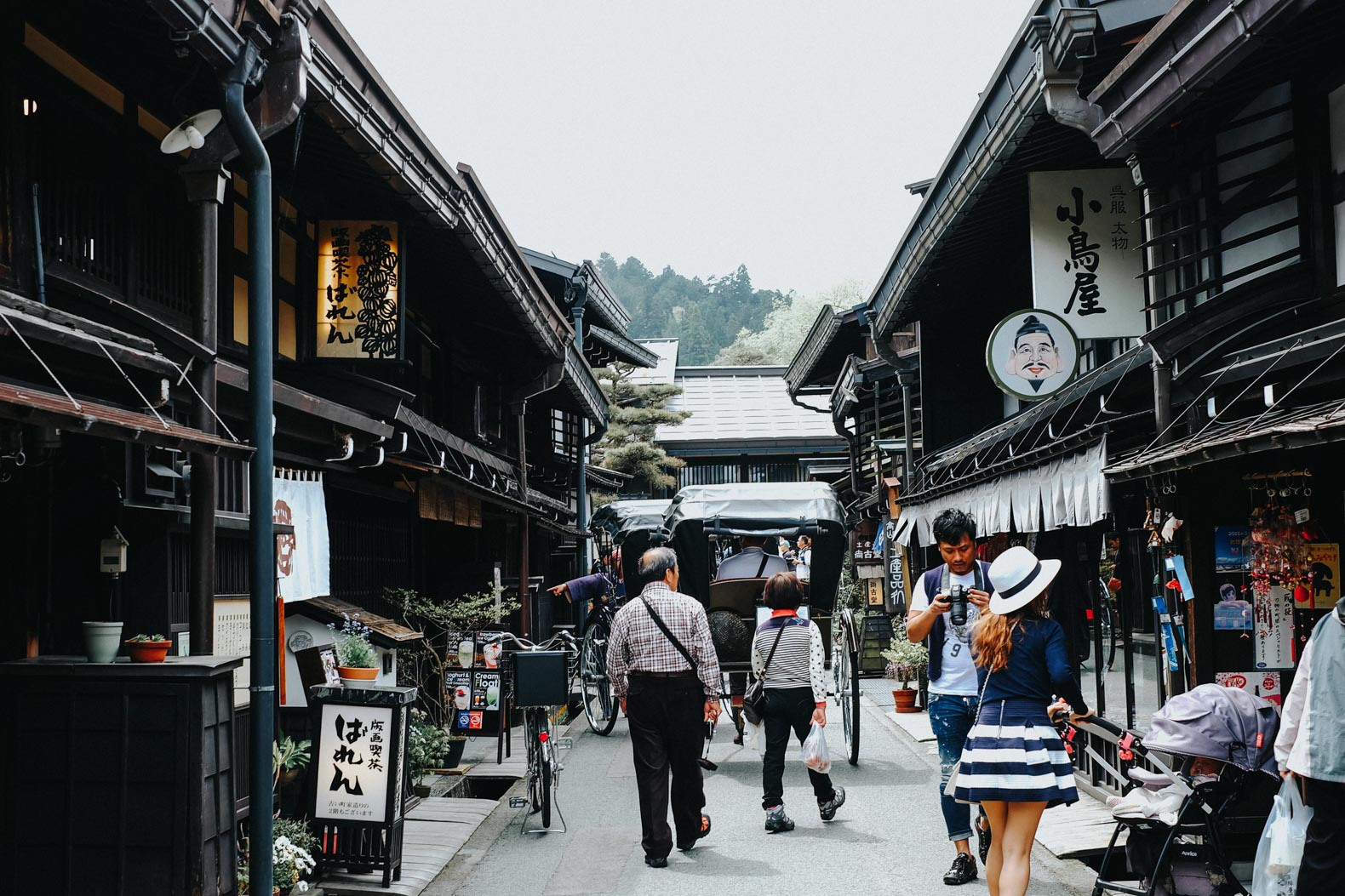
All checked in and cozy? Here are some ideas of what to do during your time in Takayama.
Things to do in Takayama
- Stroll around the Edo-era merchant district. The houses are very well preserved, although many have been converted into souvenir shops.
- Try Hida beef, the local variant similar to Kobe beef. You can go to various grill-your-own joints for a fancy experience, or get a skewer for a couple bucks at the morning market.
- Visit the morning market for handcrafted souvenirs. There are two markets, but the one along the river is far better for souviners. You can get wooden carvings made from the Japanese Yew, chopsticks in all configurations and price ranges, and of course a lot to eat.
- Indulge in a box or two of sake! Takayama has a prominent sake industry, and you can recognize sake spots around town by the dried cedar balls that hang in front of the front door.
- Buy your Japanese souvenirs, period. This is where we bought our one serious souvenir from Japan, which is a gorgeous black and gold teapot. It cost around 80 EUR (which is a pretty standard price for teapots, believe it or not!)
- Visit “Little Kyoto”. Now that you’ve been to Kyoto, you’ll realize: Takayama’s temple district is nothing like that of sprawling Higashiyama in Kyoto, but there is one distinct difference: you have the place to yourself.
Day 8: Day trip to Shirakawa-go
Enjoy breakfast in your Ryokan, check out the morning market, and in the early afternoon, hop on a bus to Shirakawa-go.
Shirakawa-go, is one of the tiny tiny villages where people still live in thatch-roof houses. Every 30-40 years the roofs are replaced by 200 community members and volunteers working quickly over two days. The town itself is a UNESCO World Heritage site, and you can go inside several of the thatched houses and learn more about life in the village.
What to know before visiting Shirakawa-go
- Shirakawa-go is visited by massive tourist crowds. No one in the blogosphere seems to admit this, but it’s a simple fact: Shirakawa-go experiences hit-and-run by tons of tourist groups.
- That said, your best option is to spend the night in Shirakawa-go in order to get a more authentic and private experience.
- Shirakawa-go’s scenic overlook is not accessible in winter. If you’re traveling to Japan in Winter, the location where you can see the entire valley at once is not accessible when the path is snowed in.
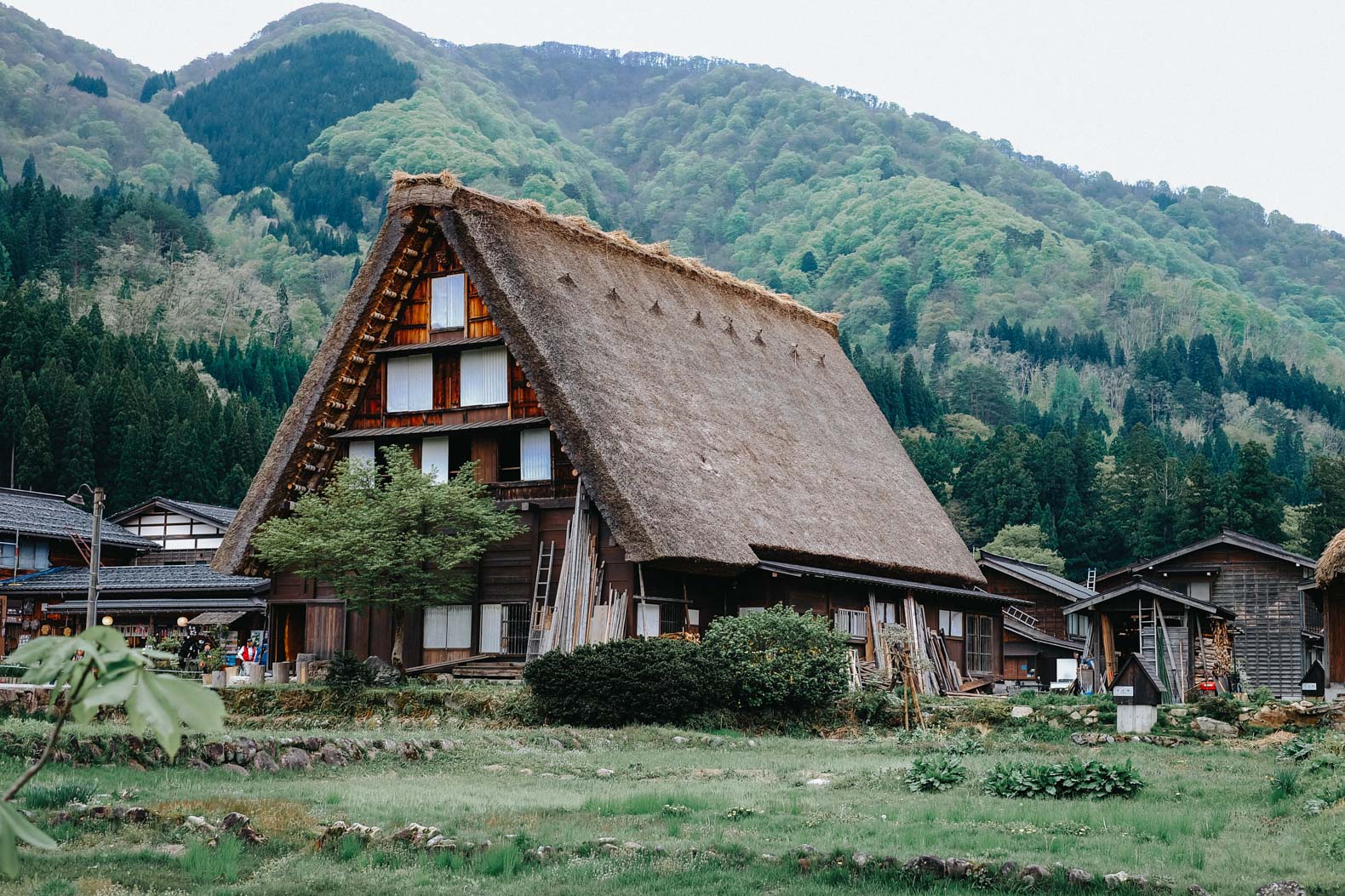
After visiting Shirakawa-go, spend your last night in Takayama. Enjoy breakfast the next morning, because it’s time to hit the road and head north.
Day 9: Travel to Aomori in Northern Japan
I will start with this: If you’re not visiting Hirosaki during cherry blossom season, I’m not sure it’s worth it. The town itself is pretty lackluster, and it’s the park filled with 2,500 cherry blossoms which makes this location truly spectacular and yet under-the-radar for western visitors.
That said, Hirosaki is probably one of the few places where we really felt like we weren’t just one of thousands of western tourists. Almost everyone in the city was either Japanese, or traveling to Japan from a neighboring country in Asia. For that reason, it was really cool to visit somewhere that felt a little undiscovered by people like us.
The trip from Takayama to Hirosaki takes about 8 hours, so most likely, you’ll arrive in the early evening, with enough time to see Hirosaki’s cherry blossoms illuminated by night.
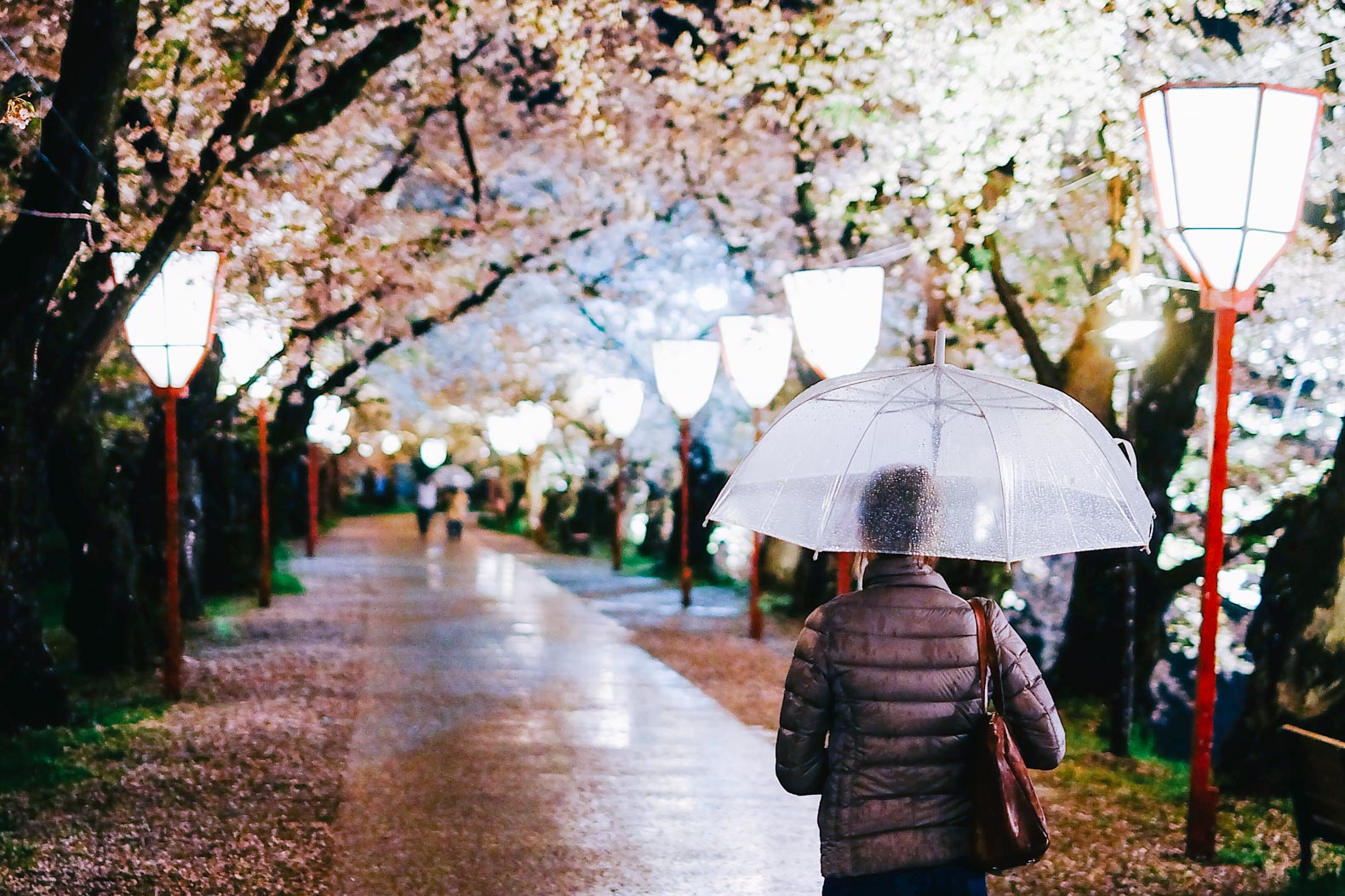
After spending the night in the park, grab dinner at
<a href="http://www.kadare.info” class="place” onclick="ga(‘send’, ‘event’, ‘Affiliate Link’, ‘Click’, event.target.getAttribute(‘href’));”
target=”_blank">Kadare Yokochō . This food hall is a favorite with locals, and offers a ton of options. You can read more about what to try here in my guide to Hirosaki.
Day 10: Spend the day at the Hirosaki Cherry Blossom Festival
The next day, it’s time to enjoy the park in all it’s bright and blooming glory. The park is overflowing with flowers, idyllic Japanese-style bridges, petal-filled moats, and one of the coolest sights: Sakura Tunnel .
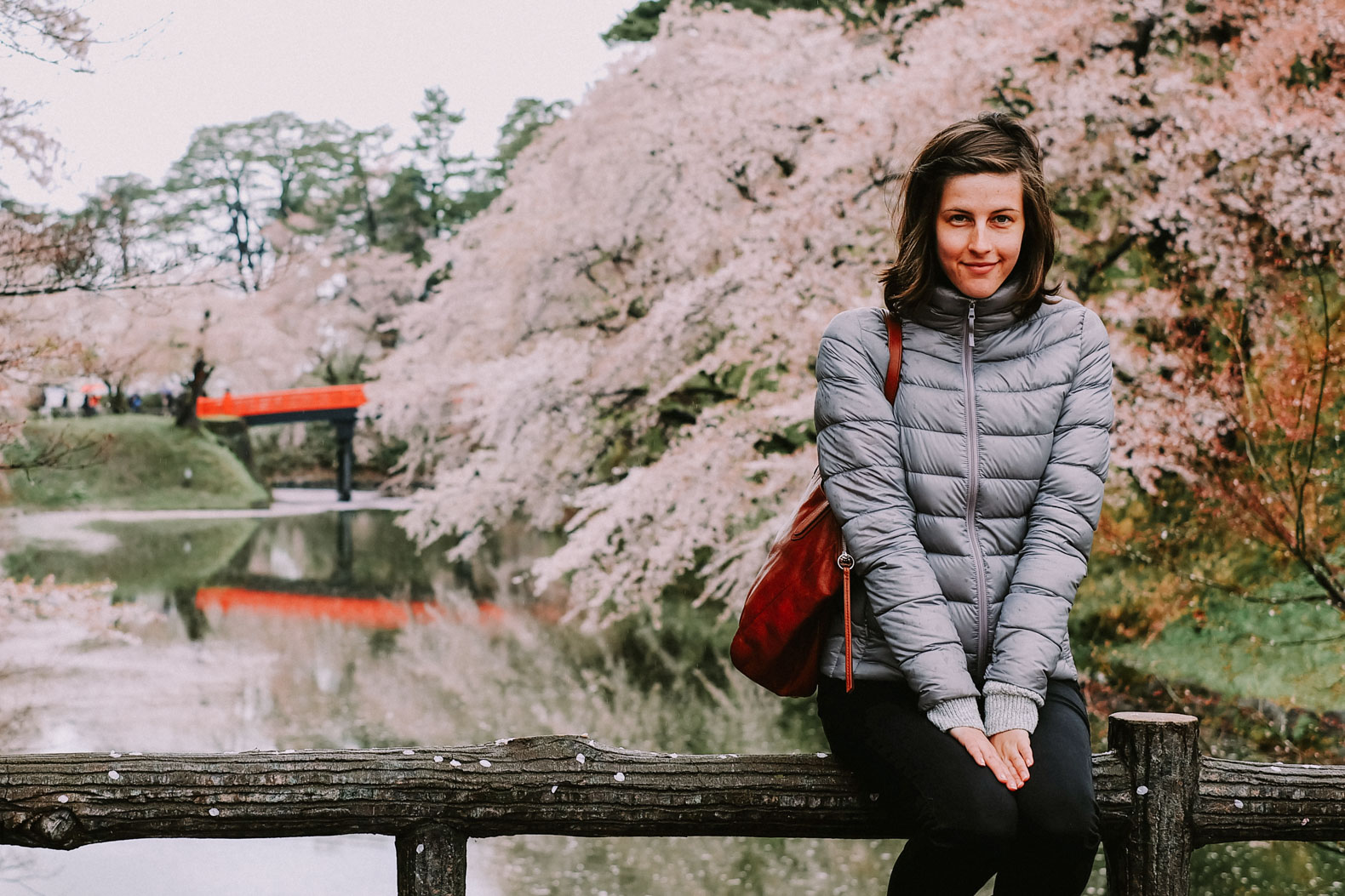
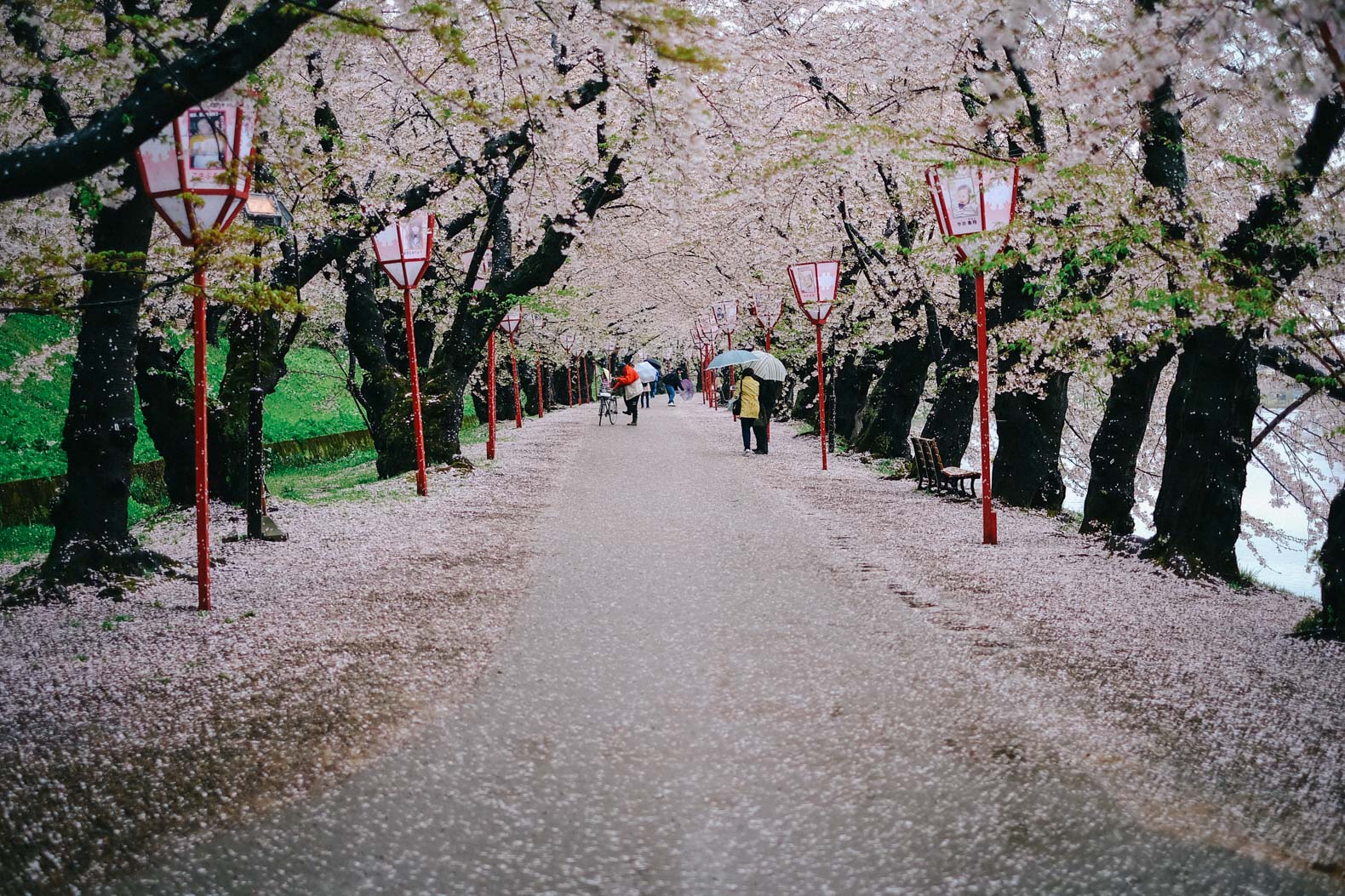
I imagine this place also looks spectacular in Autumn, but I can only tell you: it’s gorgeous in Spring, and perfect if you’re making a late Spring trip, where the cherry blossoms in more southerly locations will have already gone.
Tonight, take the train to Nikko, Japan, a town a short way from Tokyo but packed full of historic locations and natural wonders!
Day 11: Experience beautiful Nikko
I made a critical mistake when coming to Nikko. I came during Golden Week, which happens at the beginning of May. During this time, the entire country of Japan is basically on vacation, and of course, where do they go on vacation: why, Nikko!
And it’s no wonder: Nikko was once a favorite retreat for the emperor, once he had moved his residence from Nara to Tokyo. As a result, Nikko has some of the most concentrated famous sights in Japan. In fact, a huge swath is a designated UNESCO World Heritage Site. For a small town, this place has got a lot going on.
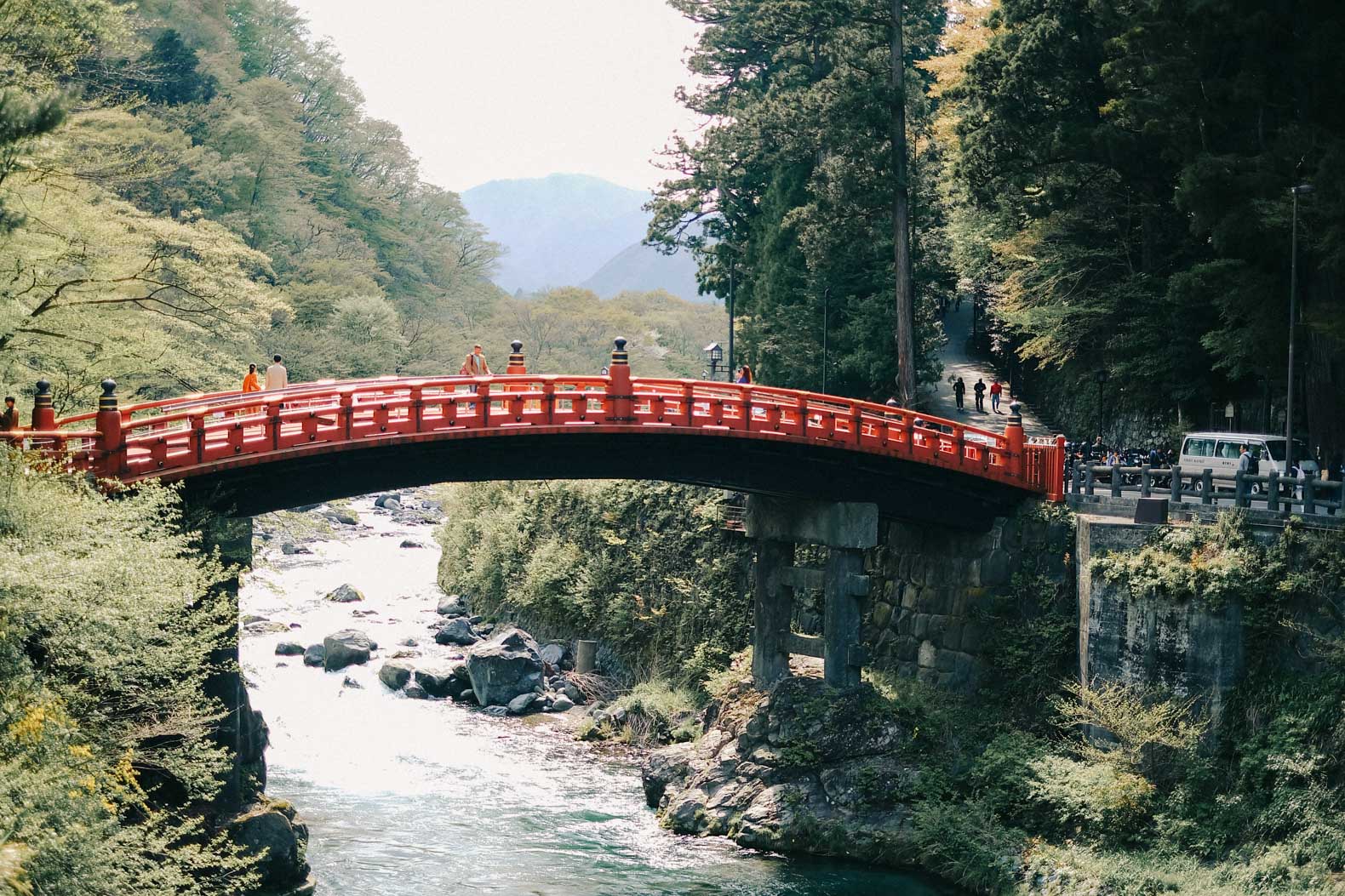
Things to do in Nikko (AKA more shrines 😄)
- Shin-kyo – The most famous bridge in Nikko (pictured above). There’s a fee if you want to cross it, but perfectly good photos can be taken fo’ free.
- Tosho-gu – This group of buildings that comprise the Tosho-gu shrine comprise several buildings. Each structure offers something different. Here are a few of them:
- Yomeimon (Gate of Sunlight) – Perhaps the climax of Nikko’s temple district, this gate is unique because it’s just so gaudy. Gold everywhere, super ornate. The only problem is that it’s currently under rennovation until March 2019.
- Naikiryu (Crying Dragon) – Enter the Yakushi Hall at Tosho-gu and see, painted on the ceiling, an enormous dragon. It’s believed that the sound of wooden blocks clapping together in this room sound like the dragon is crying (depends on how imaginative you are if you ask me!)
- Kegon Waterfall – I didn’t have time to see this myself, but if you stay a little longer in Nikko, you can take the trip here. Nikko has a few other waterfalls, but Kegon is easily the most popular.
Now, after all of this, I was honestly left pretty overwhelmed by Nikko. 99% because the crowds were so dense, it was totally uncomfortable to view some of these places. The other 1% was probably actually being underwhelmed because of some of the construction that covered the coolest structure, Yomeimon.
Actually, I wanted to LEAVE. Luckily, Nikko still had something waiting for me…
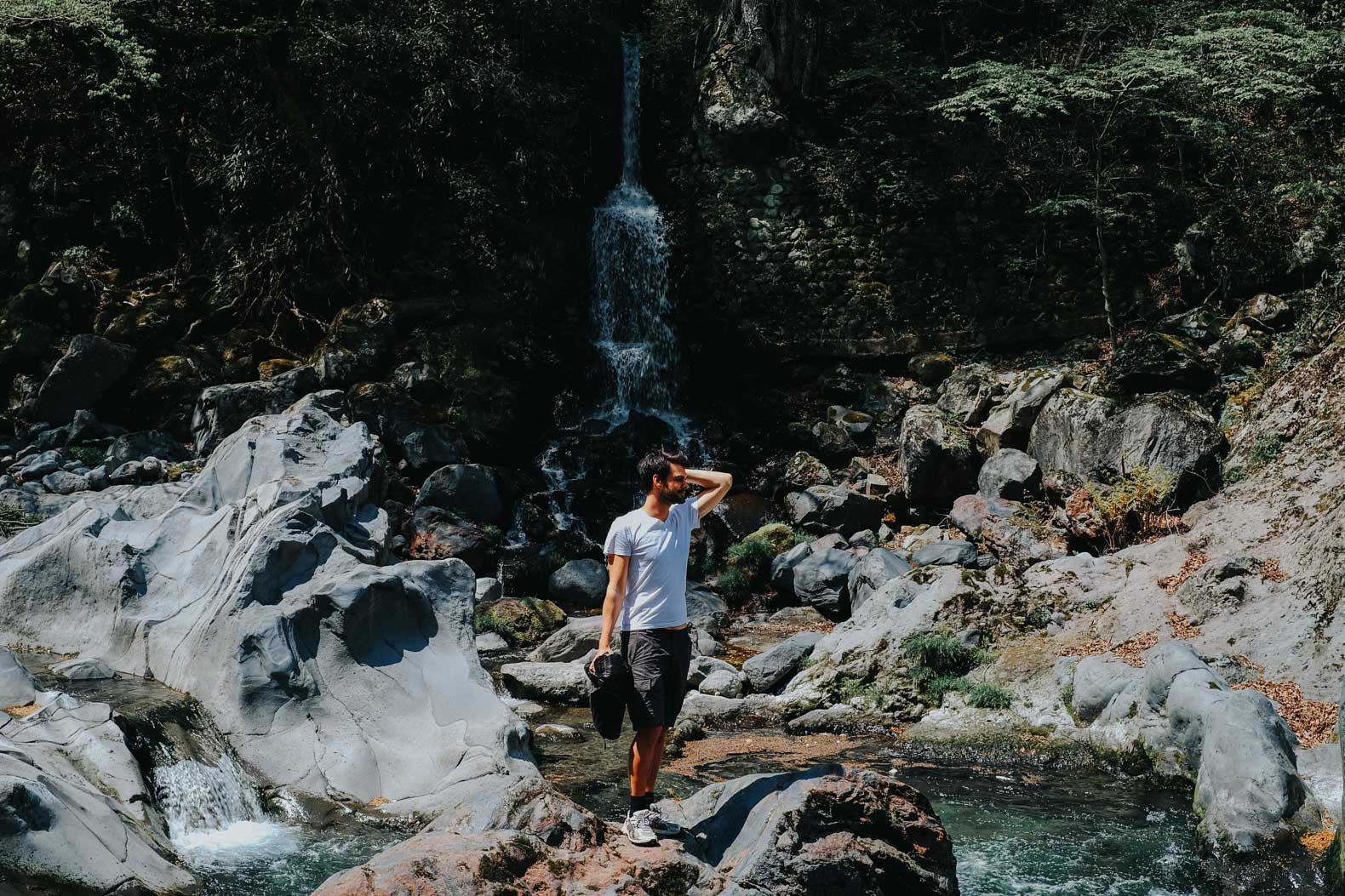
Kanmangafuchi Abyss
After a tasty and expensive slice of cheesecake and coffee at Nikko Coffee , we embarked on a walk to the Kanmangafuchi Abyss . This natural canyon in Nikko is like the polar opposite of Tosho-gu. Somehow no one else knew that there was this natural treasure just a kilometer away from the popular shrines. It turned out to be one of the most beautiful places in Japan.
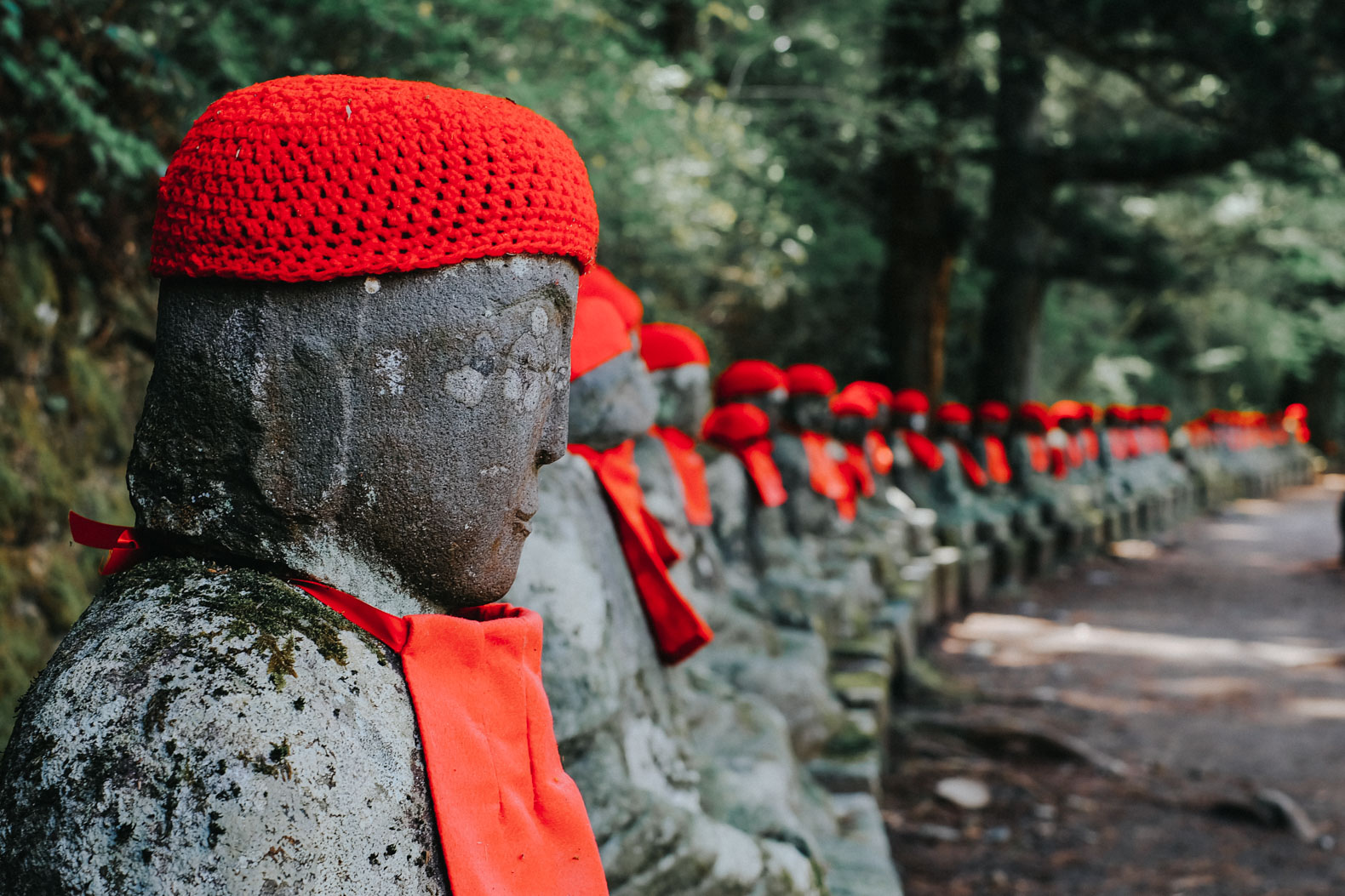
On your way in, these statues line the path to the gorge. It’s said that it’s not possible to count the name number of Bake-jizo on your way in as on your way out. You’ll just have to try for yourself! (Spoiler: I failed, but I don’t blame any inanimate objects for that).

Enjoy your time in Nikko, because after this it’s back to the big city! Pick up your stuff from the hostel, hop on a train, we’re going to Tokyo…but for real this time.
Day 12 and 13: Time for Tokyo
A lot of people who come to Japan spend a lot of time in Tokyo. I mean, it makes sense: it’s got the most restaurants per capita in the world, you could spend a lifetime exploring every conceivable experience this city can offer. That said, I didn’t try to do Tokyo hardcore. For one, I actually visited friends while here, which tends to make everything a little less go-go-go. On the other hand, there is just so much there, your chances of “making a dent in Tokyo” are miniscule, so why try!
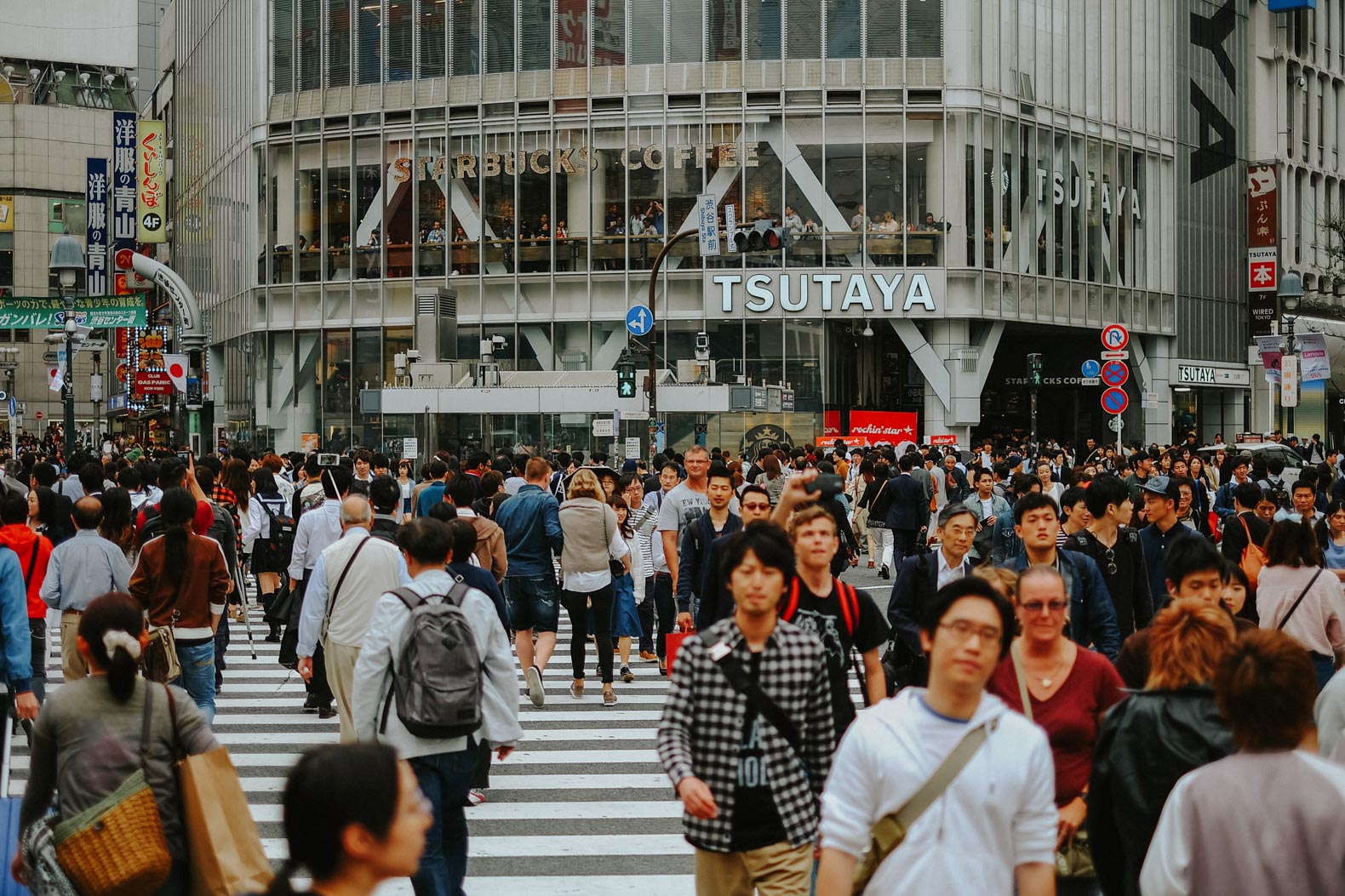
Ideas for what to do in Tokyo
- Ascend the Tokyo Skytree. If you’re scared of heights (like me), this place is going to make you SO NERVOUS. The highest point in the city, on a clear day you can see Mt. Fuji which is 100 kilometers away.
- See the faithful Hachiko statue at Shibuya station. Perhaps you’ve heard the story of the faithful dog that waits for years at the train station, even 9 years after his owner has passed. If you want to see this world famous symbol, head here – also a popular meeting place!
- Take a walk through the Yoyogi Park. You’ll see buskers, groups of friends, maybe even the famous
<a href="https://www.youtube.com/watch?v=BLl9GERTMYg” onclick="ga(‘send’, ‘event’, ‘Affiliate Link’, ‘Click’, event.target.getAttribute(‘href’));”
target=”_blank">Tokyo rockabilly dancers .
- See the Shibuya Crossing. One of the most famous sights in Tokyo, this crosswalk is the busiest in the whole world. If you’re in the area, be sure to check it out – you can get a view over it from a 2-storey Starbucks across the street.
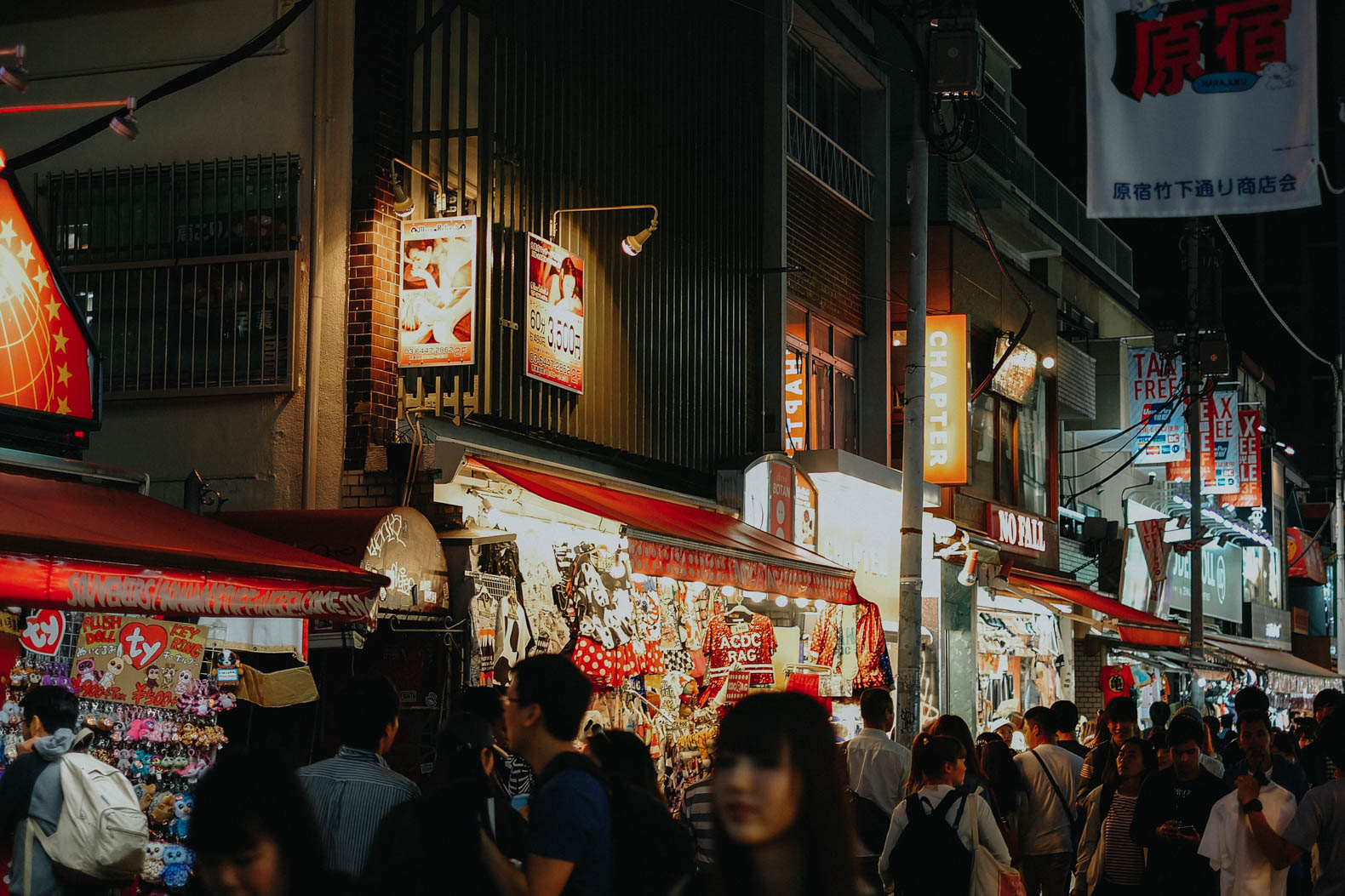
- Visit the Tokyo National Museum. Learn more about the culture and history associated with Japan in this museum. It’s got art, statues, scrolls, outfits, armor, pottery – so many things you can see develop over time with the Japanese people.
- Eat a meal at the Tsukiji Fish Market. If you missed it on your first night, now’s the time to come back! Wake up at the crack of dawn to see the daily haul of tuna, or come by in the evening to grab some dinner.
- If you haven’t gotten enough of shrines, check out Meiji Shrine. Easily the most popular shrine in Tokyo! Unlike so many shrines, admission here is free.
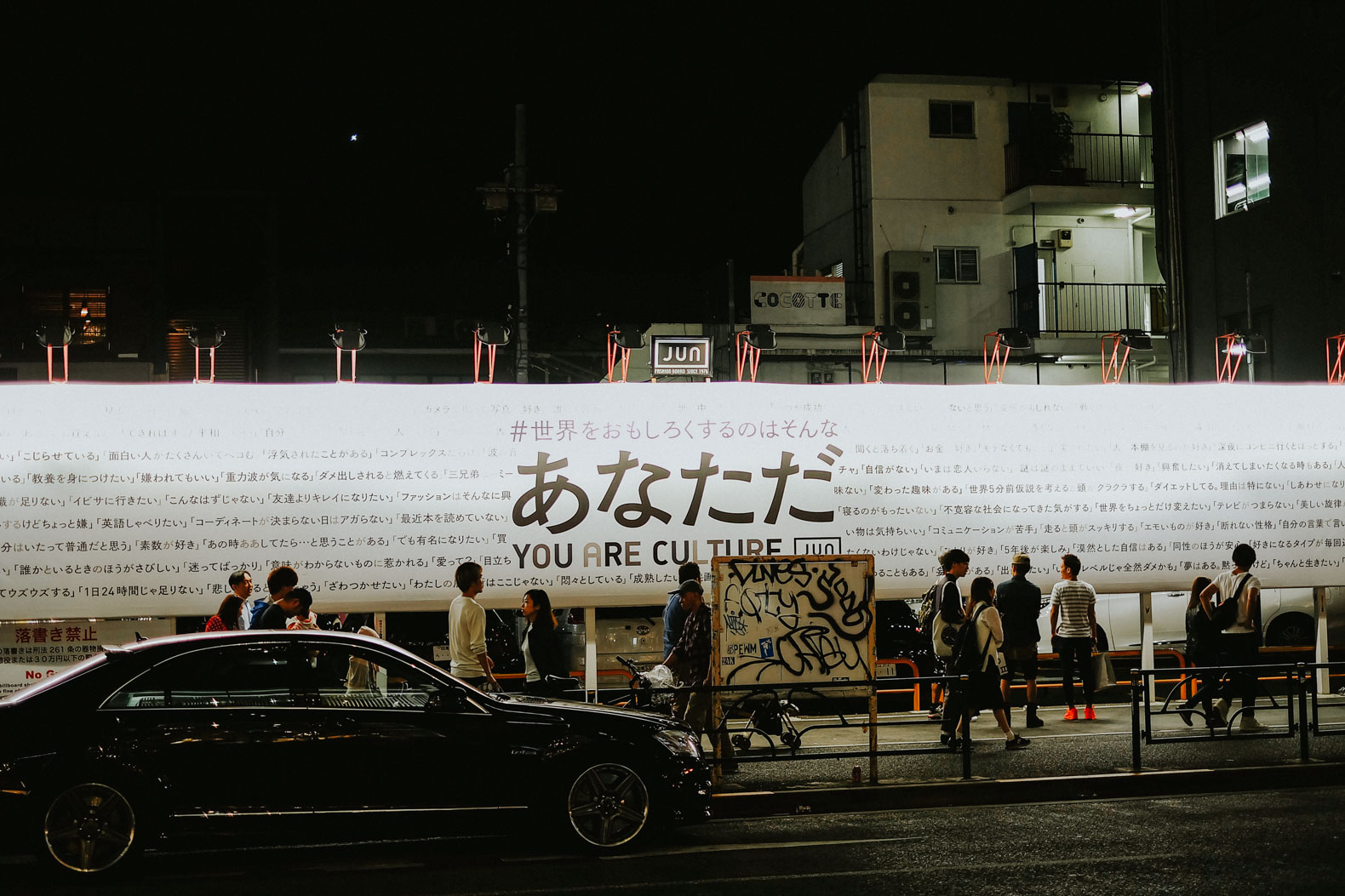
- Do some luxury shopping in Ginza. Essentially every world famous fashion brand has a flagship store in this shopping district. If you’re a luxury traveler, this might be the perfect place to pick up your Tokyo souvenir.
- Go to Harajuku and feel extra ordinary. This area has some of the most eccentric people you’ll see in the city, with the very best outfits and hairstyles. It’s a must-see area if you love people-watching!
- Stock up on electronics in Akihabara. Known affectionately as Electric Town, Akihabara is a bright and loud neighborhood and home to the largest electronics store in the world, Yodobashi Akiba.
- Got more time in Tokyo? Find more things to do in this Tokyo 5-day itinerary or go to one of many amazing day trips from Tokyo .
After your last day in Tokyo, take the train to Kawaguchi-ko and sleep at the base of Mt. Fuji. Wake up early the next morning to enjoy the mountain!
Day 14: Spend the day at Mt. Fuji and fly home in the evening
It’s the last day, you can do it! Get up as early as you can muster to see Mt. Fuji in the morning light, reflected in Lake Kawaguchi. Conventional wisdom states that your best viewing of Mt. Fuji happens first thing in the morning, but for us, the mountain became more visible as the day went on. By the end of the day, it was clear and big and blue.
I’ve gone in-depth about the best places to view Mt. Fuji, especially if you’re going in Spring, but one thing I can’t help but mention here is the Pink Moss Festival ! You can take a bus here from the main station in Kawaguchi-ko, and travel to a spot closer to the mountain that is just covered in pink flowers.
In terms of booking tickets to the festival, I just happened to discover it thanks to a brochure in my hotel. Check the website for admission tickets. There’s also tons of different ways to get to the location by bus, just check on the website’s “Access” page.
In 2019, the Pink Moss Festival is happening from April 13th - May 26th! That means you can still visit this year if you’ll be arriving between now and the end of May.
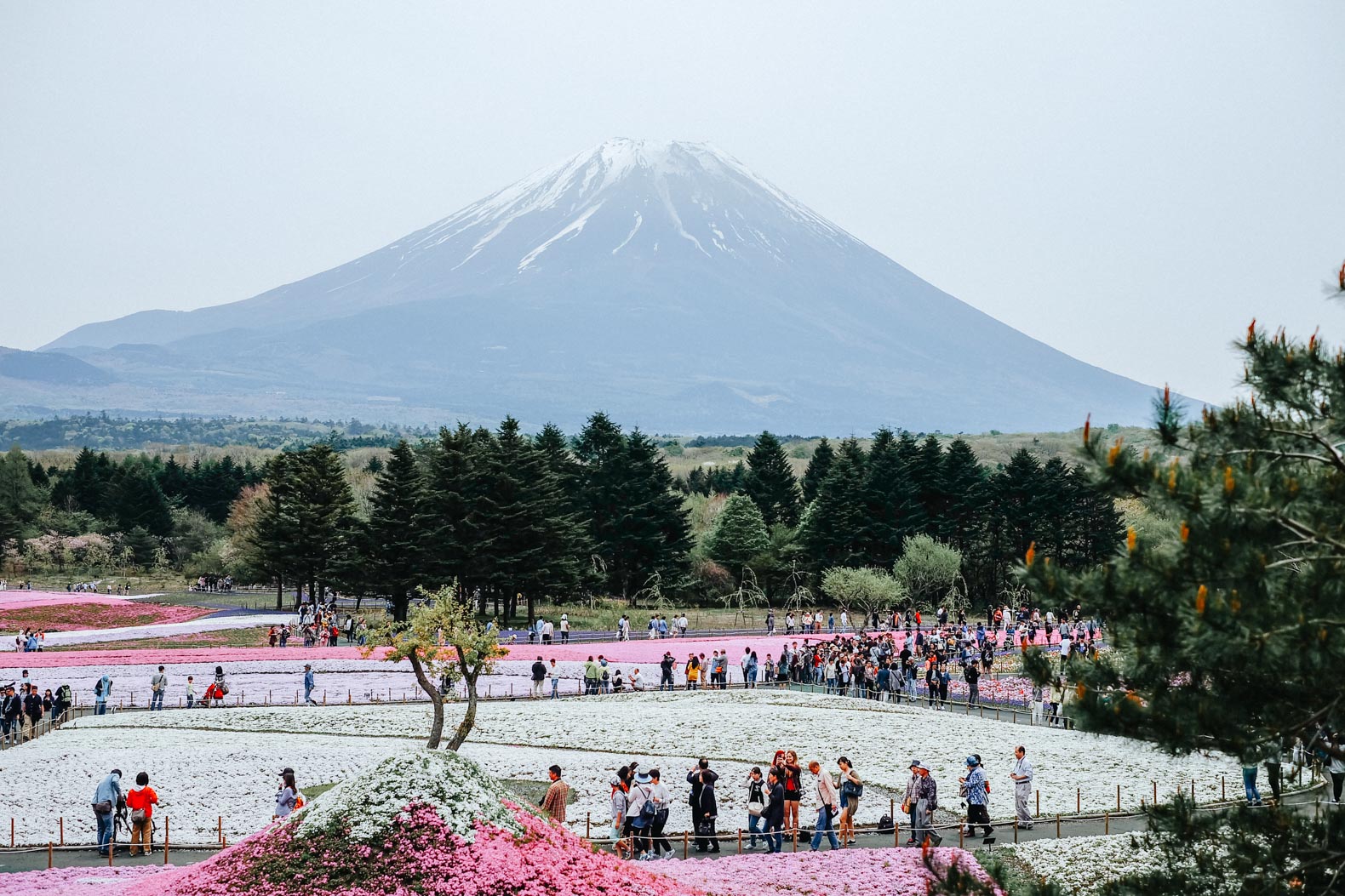
How cute is this? There’s even a mini-Fuji made out of flowers! After you’ve had your fill of flowers and too-perfect shots of Mt. Fuji, take a bus back to down and spend any free time you have walking around the lake and walking around town. Get your last matcha ice cream or any last-minute Fuji-themed souvenir.

Alas! It’s time to take the train back to Tokyo, transfer to transport that’ll take you to your airport, and start the long journey home.
And that’s a wrap!
Have you ever been to Japan? Or are you planning a trip RIGHT NOW? Would love to know about anywhere I missed in my itinerary or what you would do differently! Leave a comment with your thoughts!
Did you find this post useful? Pin this post for later!


